Looking for herb plants that live for more than two years without needing to be replanted? This list of 33 perennial herbs features herbs to use in cooking, for medicinal use, and to add interest to your garden.
Each hardy herb in this list includes a description of its key traits—leaf shape, growth habit, scent, and flower color—along with images and names for identification.
You can also download a free herb identification printable from the project card at the bottom of this post.
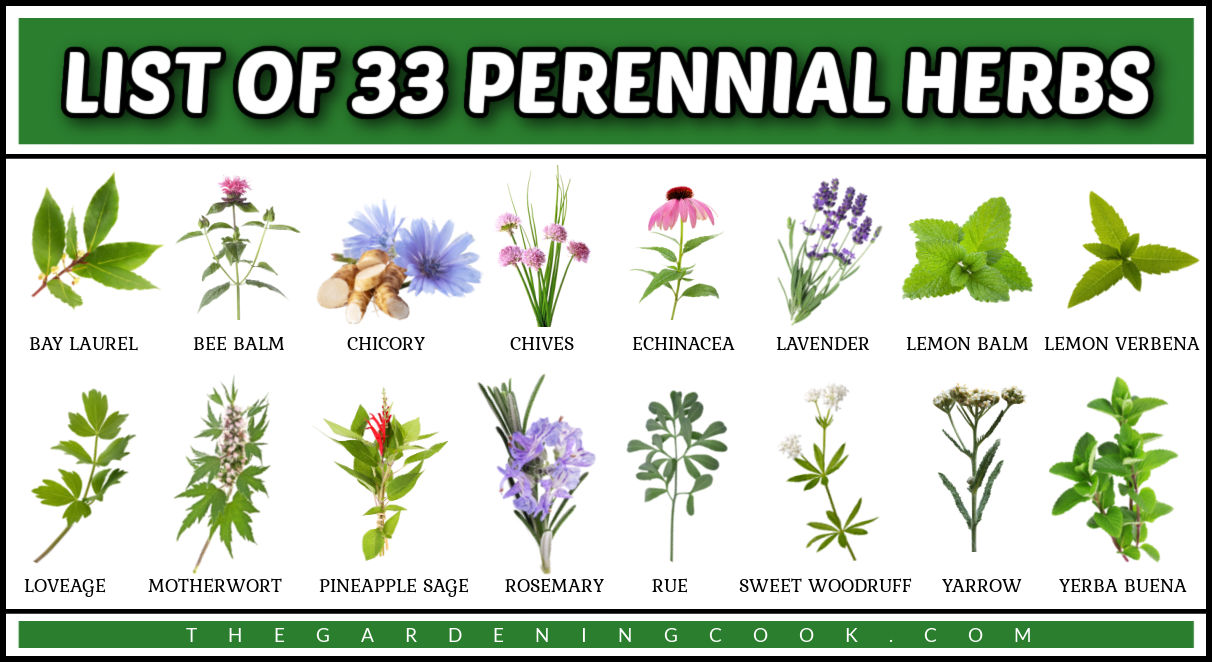
Some of the links below are affiliate links. I earn a small commission, at no additional cost to you, if you purchase through an affiliate link.
How to use this list of perennial herbs
This list of perennial herbs is in alphabetical order. The links below will take you straight to the herbs you’re looking for:
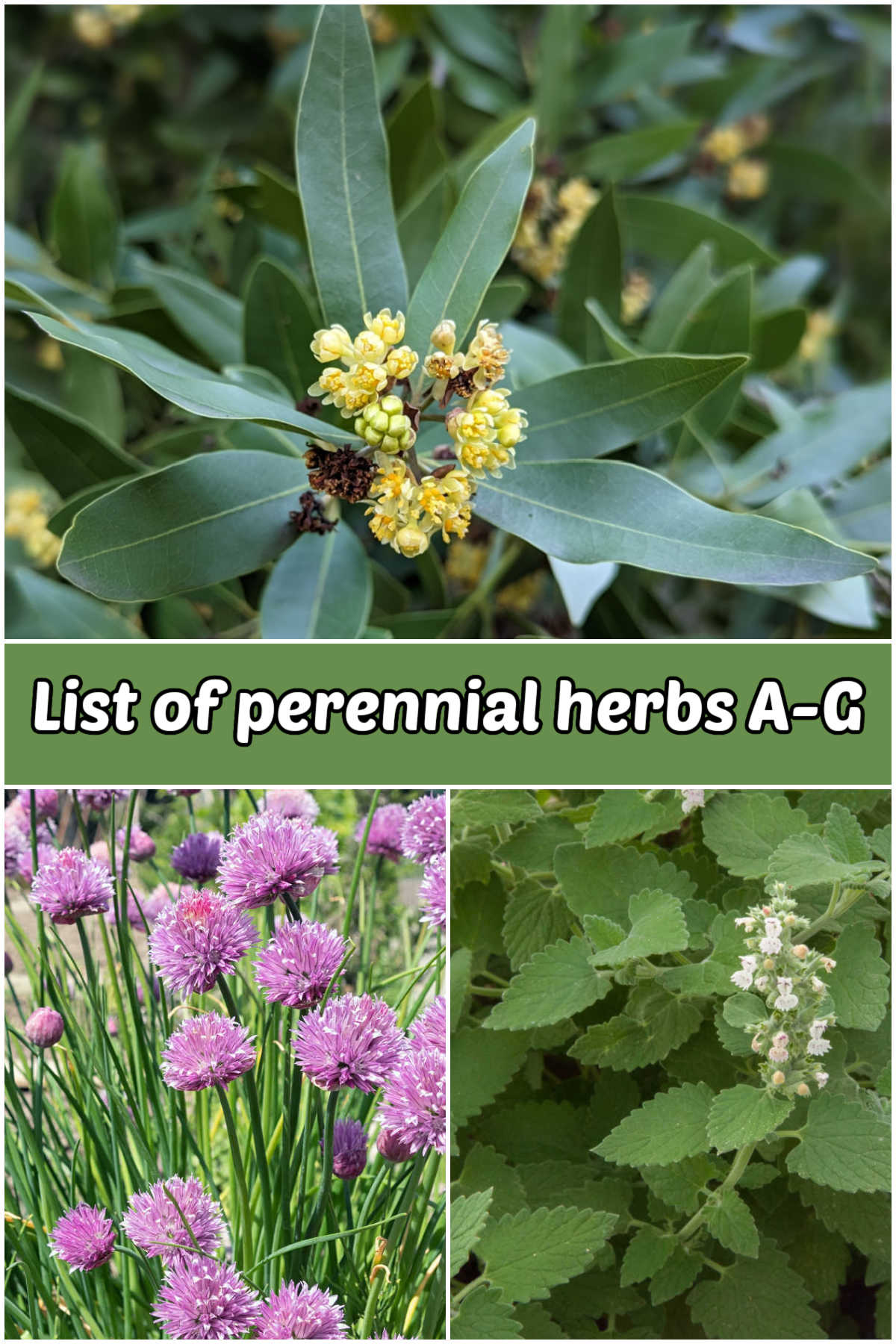
Perennial herbs list A-G
The hardy perennial herbs in this section start with letters A-G.
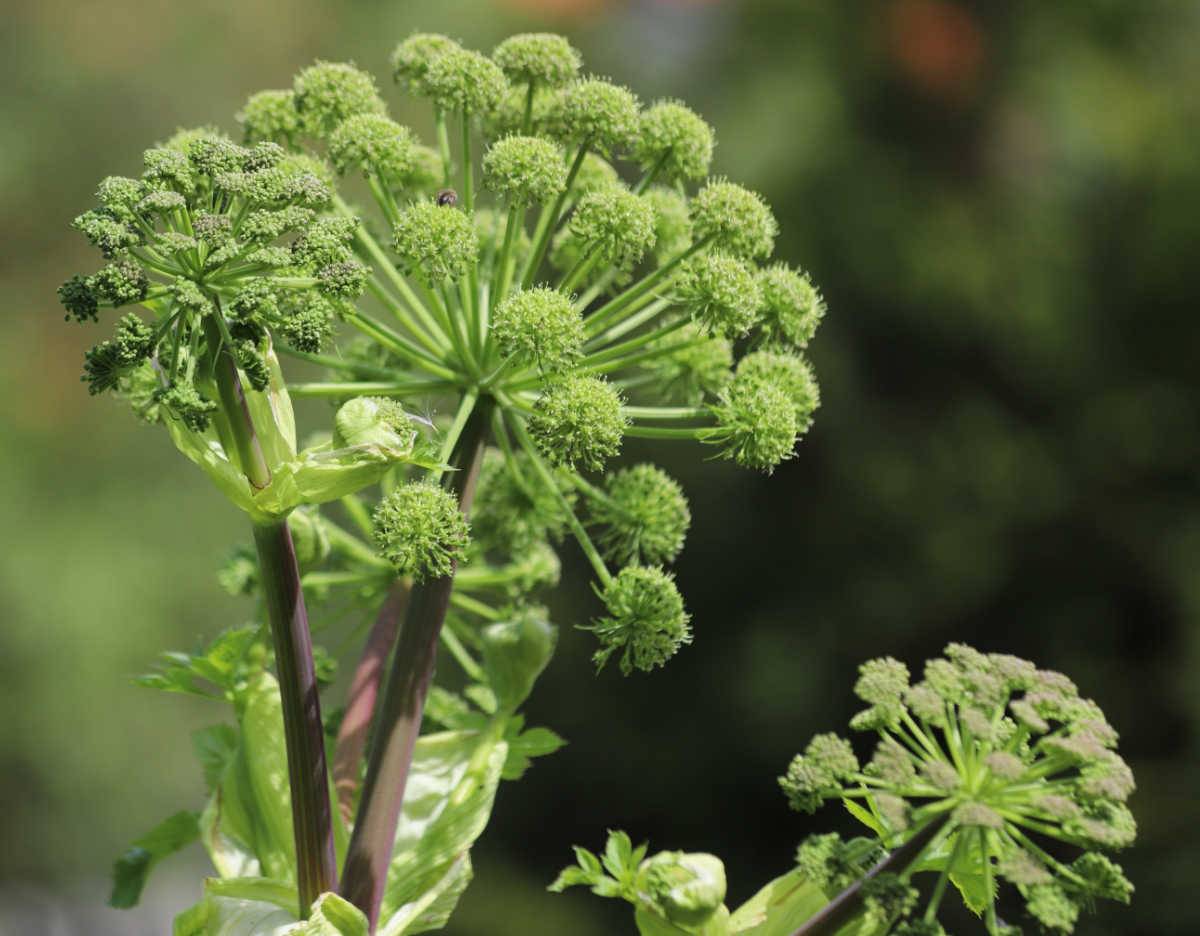
Angelica (Angelica archangelica)
This short-lived perennial herb is an ingredient commonly used in gin and Chartreuse liqueur.
- Leaf shape & texture: Large, bright green leaves with toothed edges
- Growth habit: Tall, upright, 3-6 feet (90-180 cm) tall
- Scent/aroma: Mild, sweet, and musky
- Flowers: Umbrella shaped, greenish-white flowers
- Bloom time: Early to mid summer
- Hardiness zones: USDA 5-9
- Culinary tip: When candied, the stems can be used to decorate cakes.
Buy angelica perennial herb seeds here.
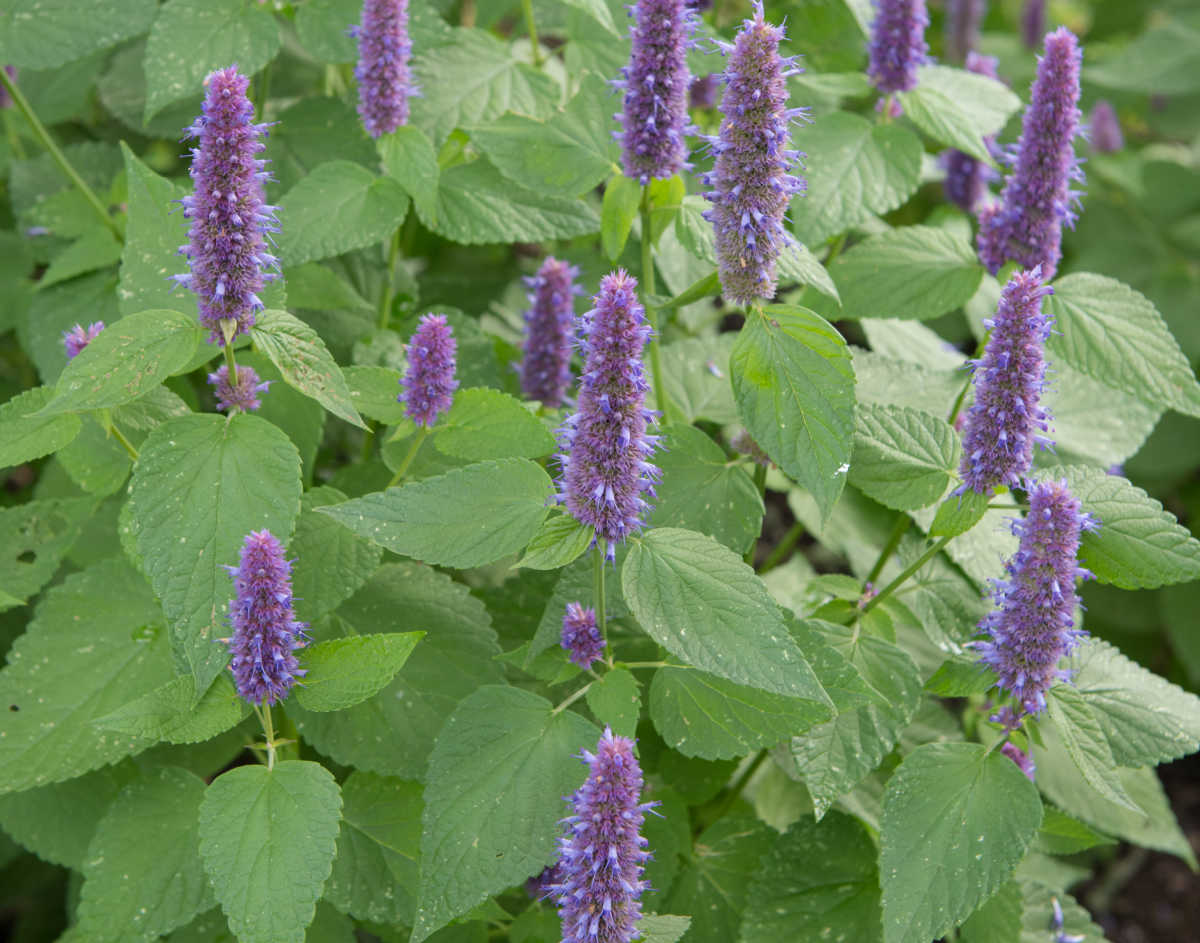
Anise hyssop (Agastache foeniculum)
This fragrant culinary herb attracts butterflies.
- Leaf shape & texture: Lance-shaped, slightly fuzzy leaves
- Growth habit: Upright clumps, 2-4 feet (60-120 cm) tall
- Scent/aroma: Sweet, licorice-like scent
- Flowers: Purple flower spikes
- Bloom time: Summer through fall
- Hardiness zones: USDA 4-8
- Culinary tip: Anise hyssop pairs well with red meat.
Get seeds to start growing the perennial herb anise hyssop in your garden.
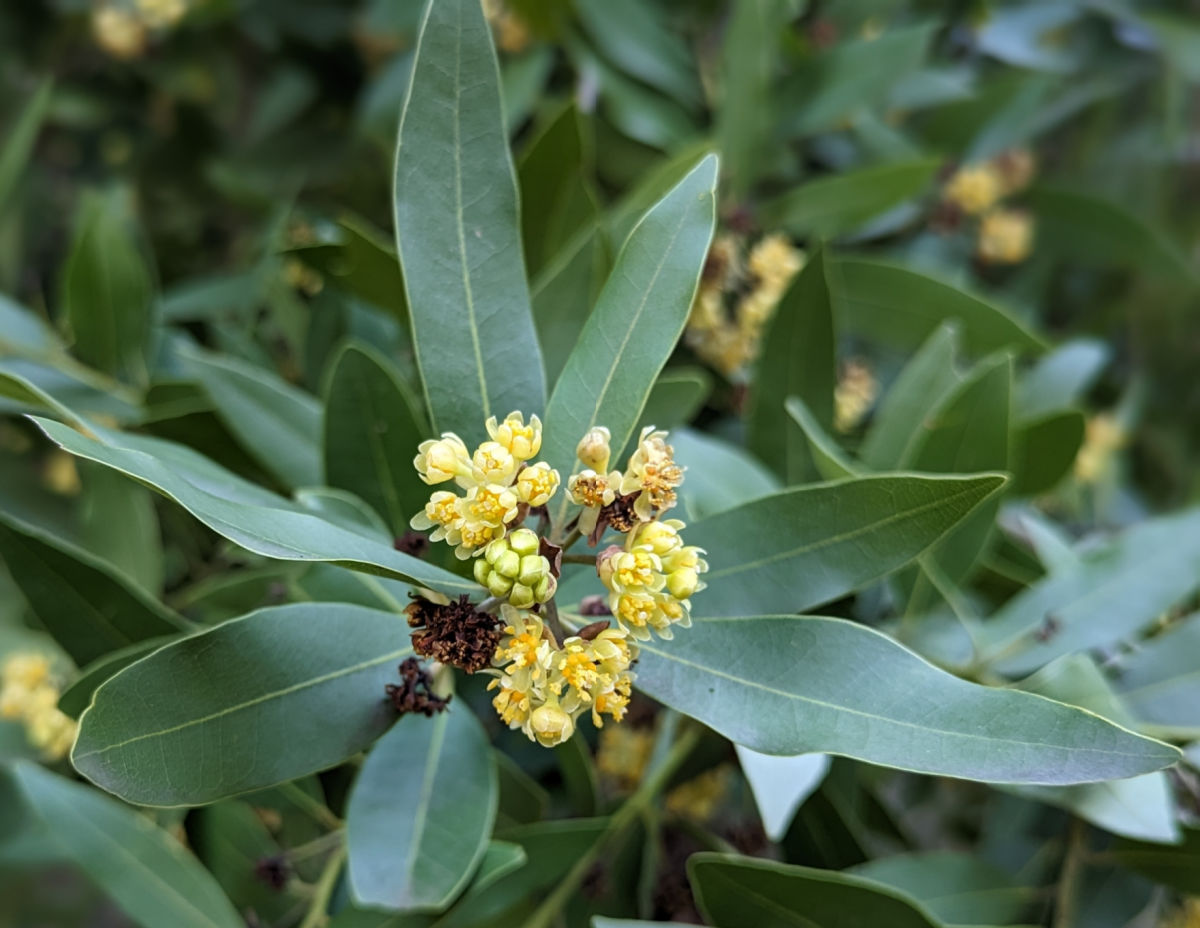
Bay laurel (Laurus nobilis)
This woody evergreen herb has aromatic leaves that are frequently used in recipes.
- Leaf shape & texture: Dark green and glossy lance-shaped leaves
- Growth habit: Shrub or small tree, 6-12 feet (180-360 cm) tall
- Scent/aroma: Strong, slightly floral bay aroma
- Flowers: Small yellow-green flowers
- Bloom time: Spring
- Hardiness zones: USDA 7-10
- Culinary tip: Fresh and dried leaves add flavor to savory dishes like soups and stews.
- Growing guide: Learn how to grow bay leaf plants here.
Purchase bay laurel live herb plants here.
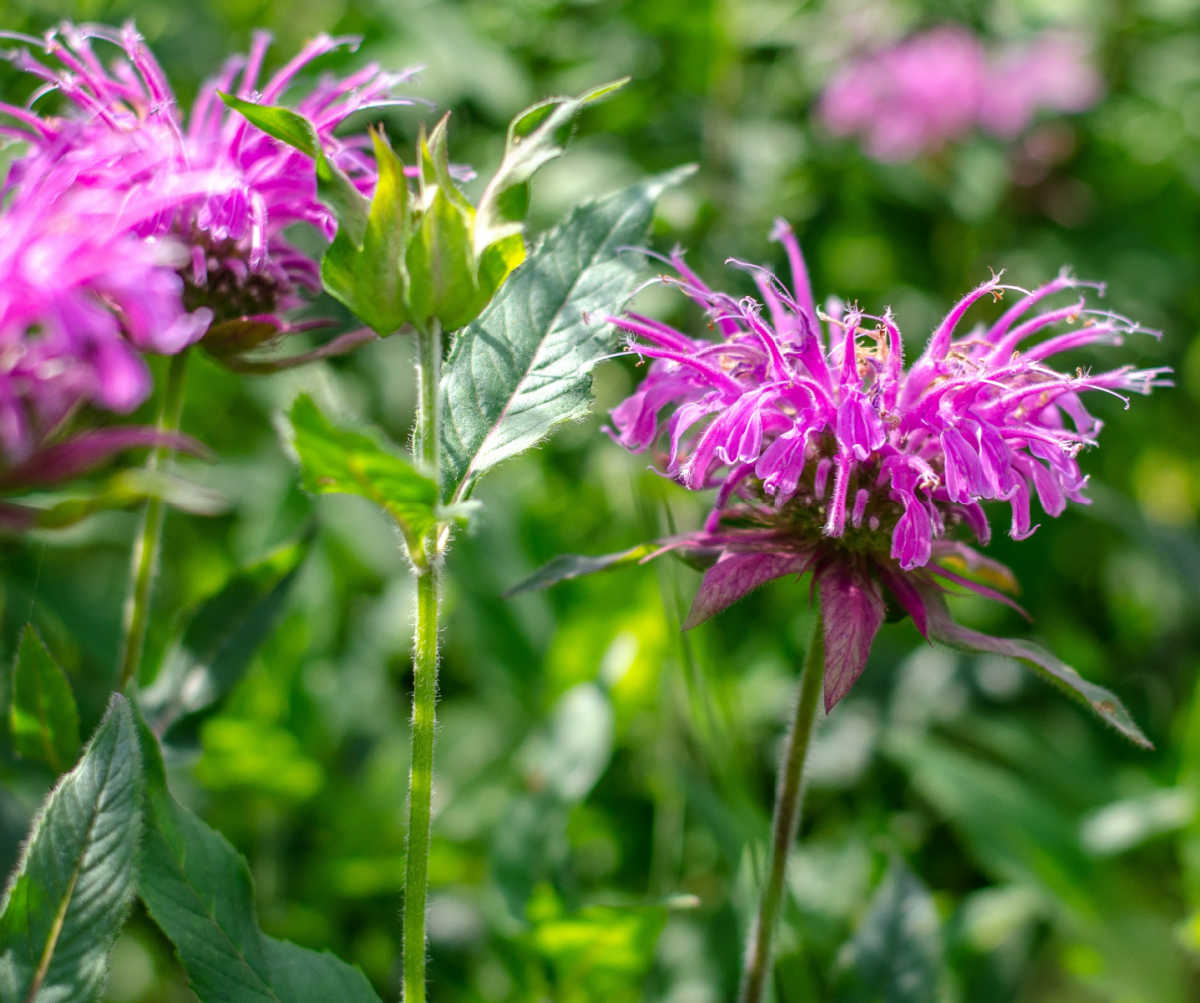
Bee balm (Monarda didyma)
It’s easy to spot bee balm in the summer because of its bright flowers. Early American colonists used the herb to make balms to soothe bee stings.
- Leaf shape & texture: Egg-shaped leaves with serrated edges
- Growth habit: Upright clumps, 2-4 feet (60-120 cm) tall
- Scent/aroma: Aromatic, minty aroma
- Flowers: Tubular red, pink and purple flowers
- Bloom time: Summer to early fall
- Hardiness zones: USDA 4-8
- Culinary tip: Use the edible flowers to add a mint flavor to salads and tea.
Shop for bee balm plants on Etsy.
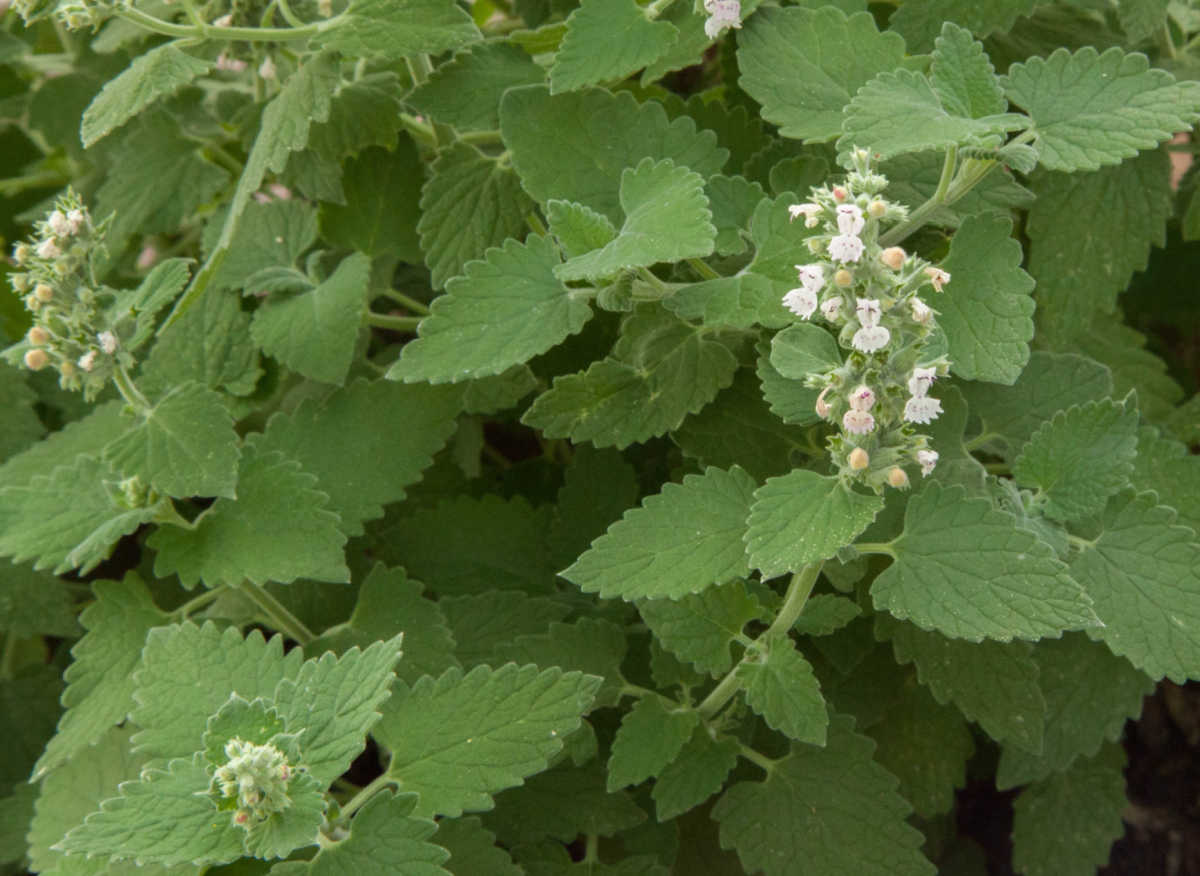
Catnip (Nepeta cataria)
Cats are susceptible to a chemical produced by catnip called nepetalactone. It effects every cat differently, but can cause them to show signs of euphoria, intense happiness, hyperactivity, or extreme relaxation.
- Leaf shape & texture: Soft gray-green, heart-shaped with serrated edges
- Growth habit: Bushy and spreads easily 2-3 feet (60-90 cm) tall
- Scent/aroma: Minty with a strong herbal fragrance
- Flowers: White to pale purple blooms
- Bloom time: Late spring to early fall
- Hardiness zones: USDA 3-9
- Culinary tip: This hardy perennial herb is used in France to season salad dressings.
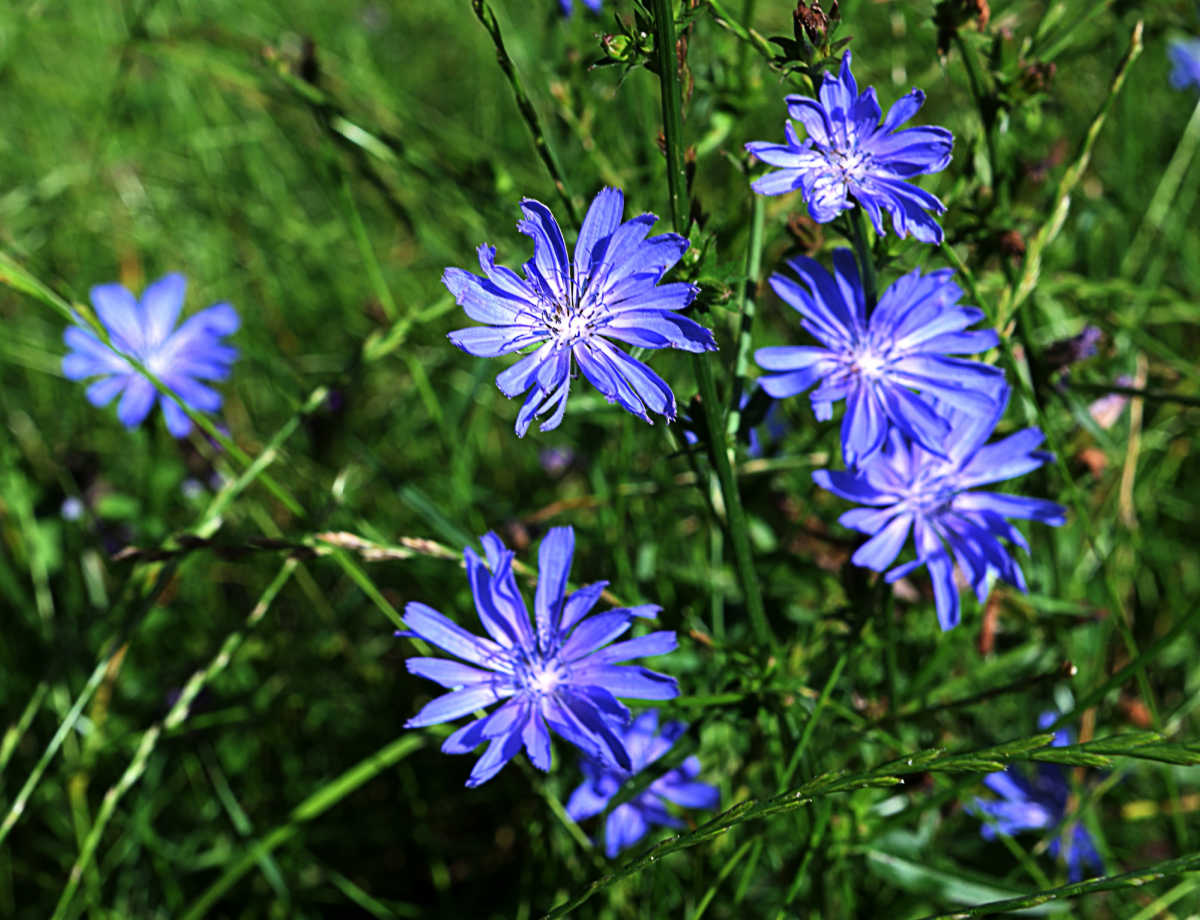
Chicory (Cichorium intybus)
The flowers of the culinary herb chicory are edible and can be used in salads or as a garnish.
- Leaf shape & texture: Lance-shaped and toothed
- Growth habit: Upright, branching stems 2-4 feet (60-120cm) tall
- Scent/aroma: Earthy and mildly bitter
- Flowers: Bright blue, daisy-like, flowers that open in the morning and close by late afternoon
- Bloom time: Summer to late fall
- Hardiness zones: USDA 3-8
- Culinary tip: Leaves are used in salads. Roots can be roasted and used as a substitute for coffee.
Find chicory plants and seeds on Etsy.
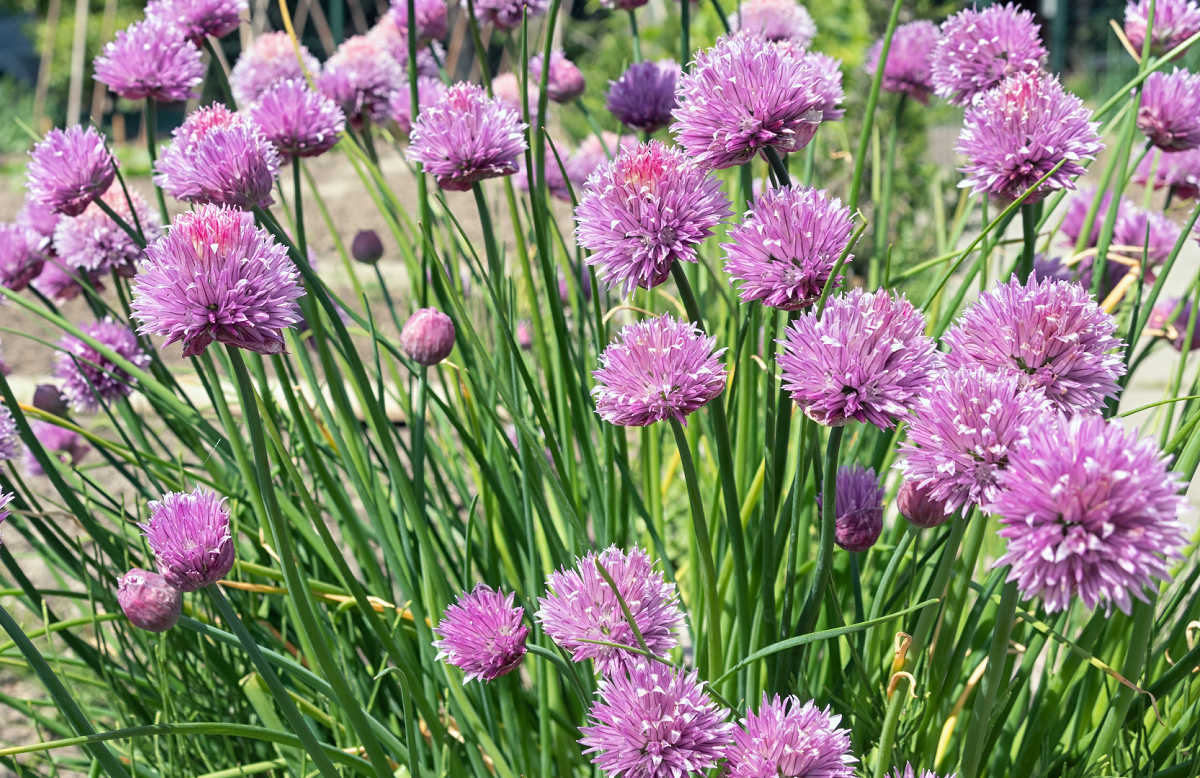
Chives (Allium schoenoprasum)
The strong aroma of chives makes this hardy herb a great companion plant for many vegetables and flowers.
- Leaf shape & texture: Thin, hollow green leaves
- Growth habit: Low clumps, 1-2 feet (30-60 cm) tall
- Scent/aroma: Mild oniony scent
- Flowers: Round purple blooms
- Bloom time: Late spring through early summer
- Hardiness zones: USDA 3-9
- Culinary tip: Snip fresh chives to use as a garnish in salads, soups, or omelettes.
- Growing guide: Learn how to grow chives here.
Purchase a live chive plant to add to your garden.
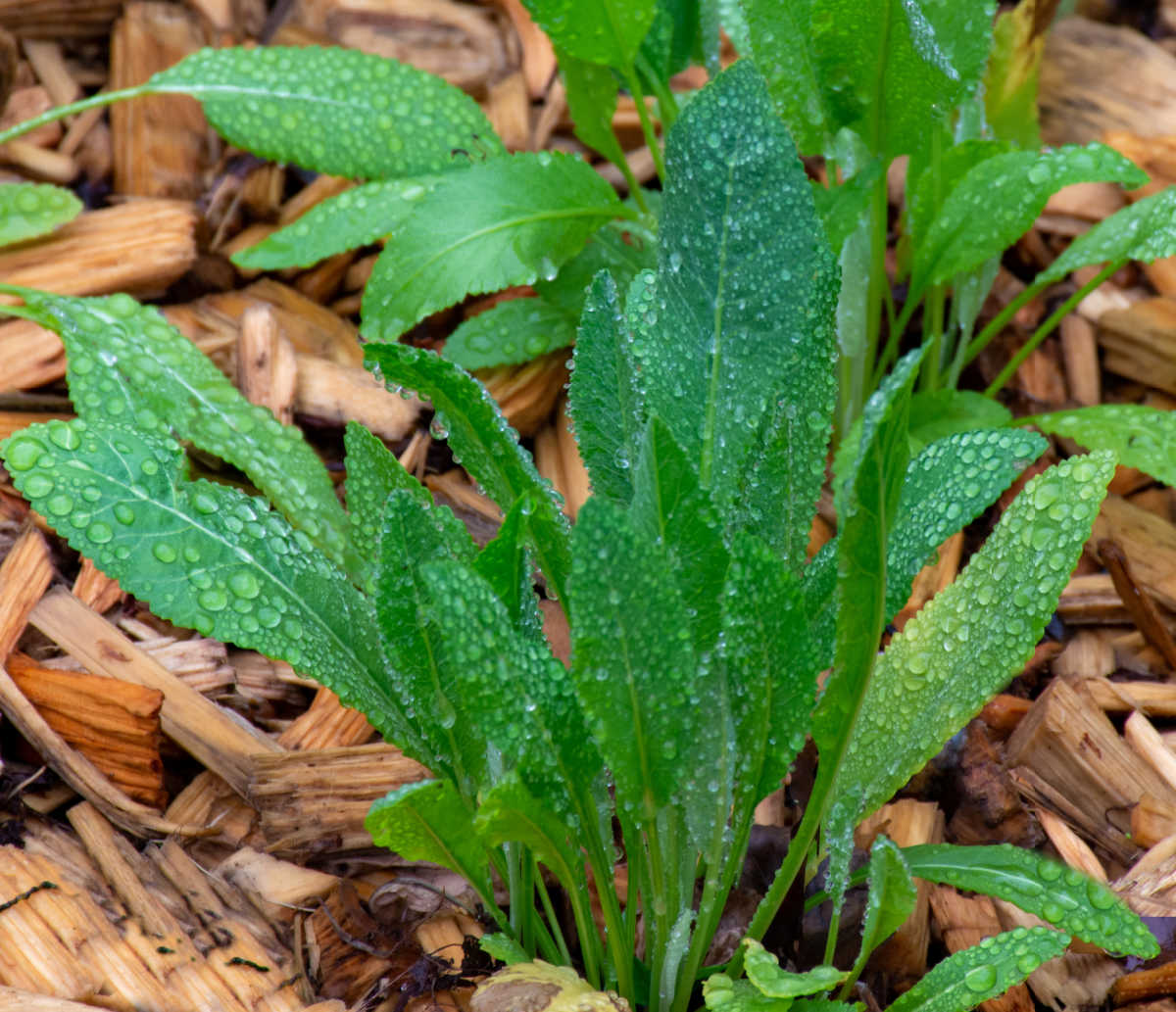
Costmary (Tanacetum balsamita)
According to some reports, costmary leaves were used as bookmarks in Bibles. Parishioners would smell this aromatic herb to stay awake during long sermons.
- Leaf shape & texture: Long, oval, silvery-green, lance-shaped leaves
- Growth habit: Upright, 2-6 feet (60-180 cm) tall
- Scent/aroma: Warm, minty-balsam scent
- Flowers: Small yellow flowers
- Bloom time: Late summer to fall
- Hardiness zones: USDA 5-9
- Culinary tip: It has a strong flavor which can be used in both savory dishes like stuffing, and sweet dishes like custard.
Buy a live costmary plant to add to your perennial herb garden from Etsy.
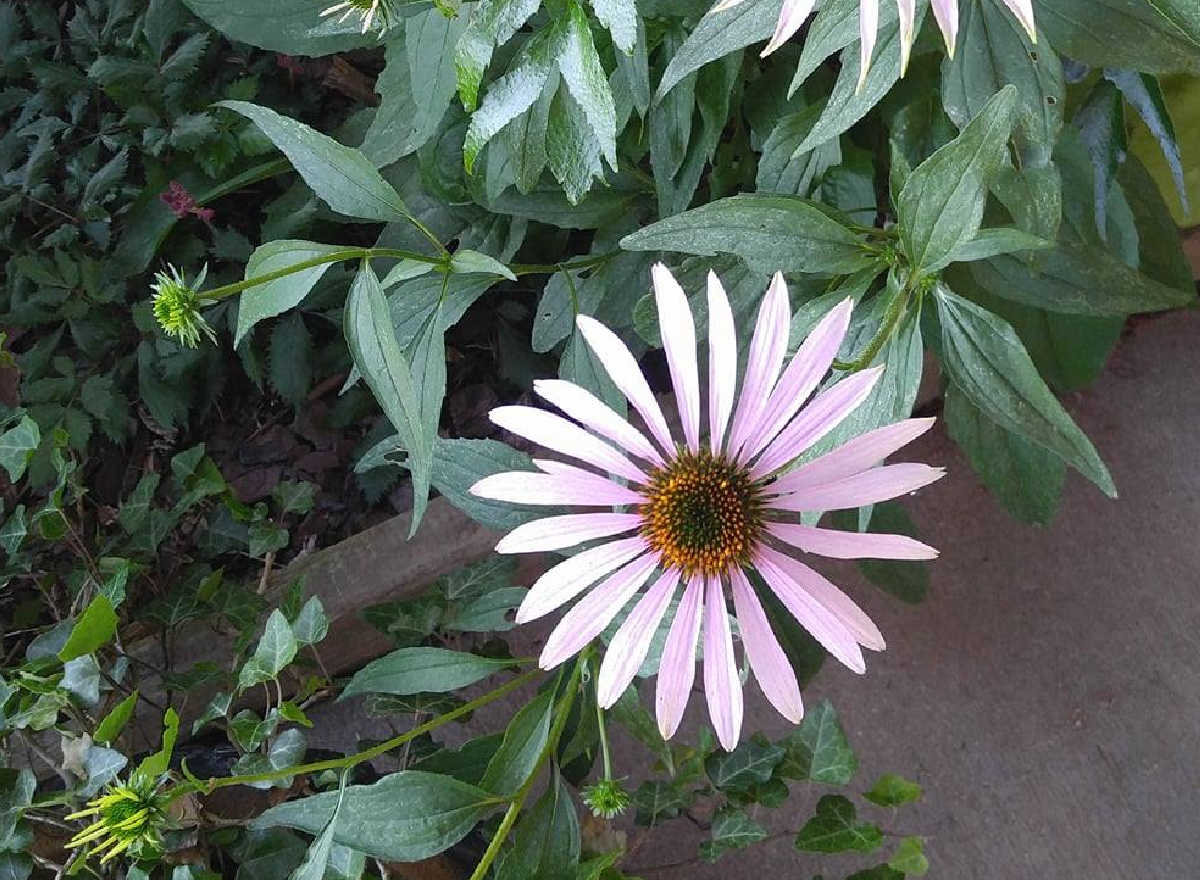
Echinacea (Echinacea purpurea)
Many gardeners think of echinacea as a flowering plant, but it is also classified as a medicinal herb because of its health benefits.
- Leaf shape & texture: Rough, lance-shaped leaves with serrated edges
- Growth habit: Upright, 2-5 feet (60-150 cm) tall
- Scent/aroma: Earthy, mildly herbal scent
- Flowers: Purple to pink petals with orange-brown central cone
- Bloom time: Midsummer to fall
- Hardiness zones: USDA 3-8
- Culinary tip: The flowers and leaves can be used in herbal teas.
- Growing guide: Learn how to grow echinacea here.
Purchase established echinacea plants on Etsy.
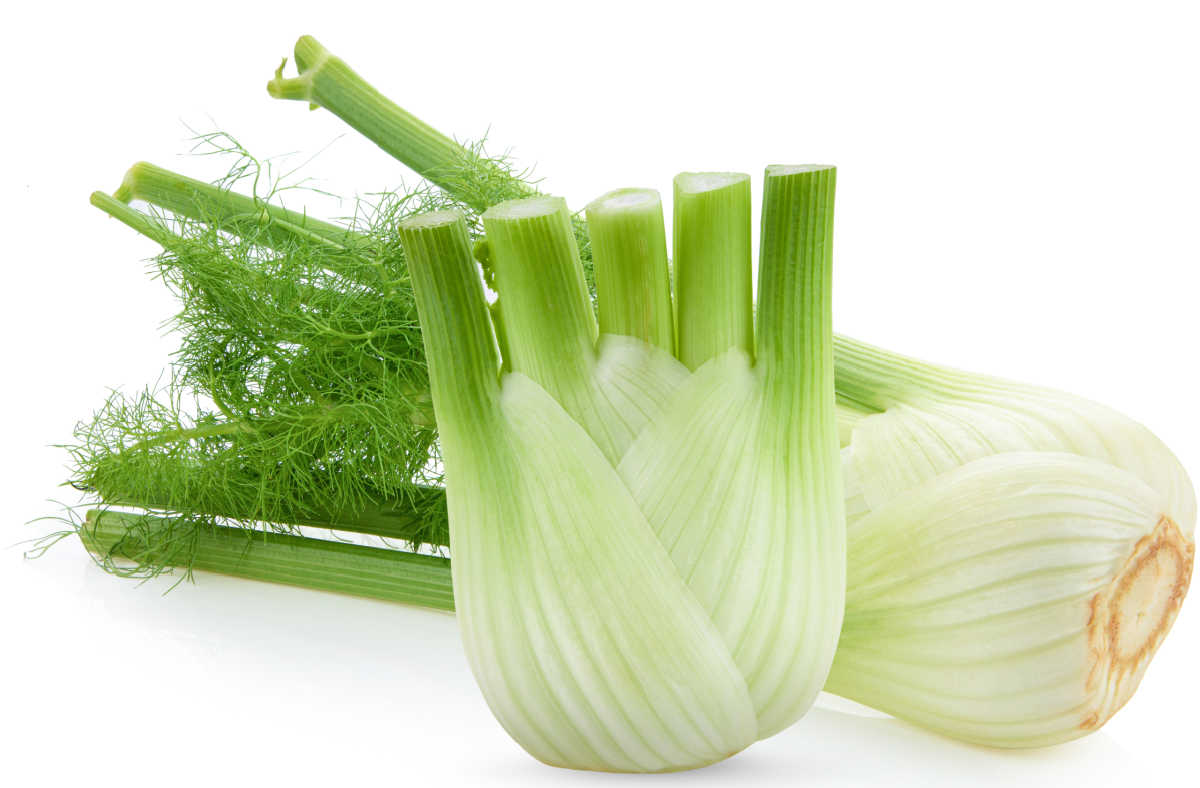
Fennel (Foeniculum vulgare)
Every part of fennel is edible – from the seeds and leaves, to the roots, and flowers!
- Leaf shape & texture: Fine, feathery leaves
- Growth habit: Upright, 3-6 feet (90-180 cm) tall
- Scent/aroma: Strong anise/licorice aroma
- Flowers: Umbrella-shaped yellow flowers
- Bloom time: Summer
- Hardiness zones: USDA 4-9
- Culinary tip: The thick, bulbous roots can be cooked or used raw in salads.
Get heirloom seeds to grow this edible herb here.
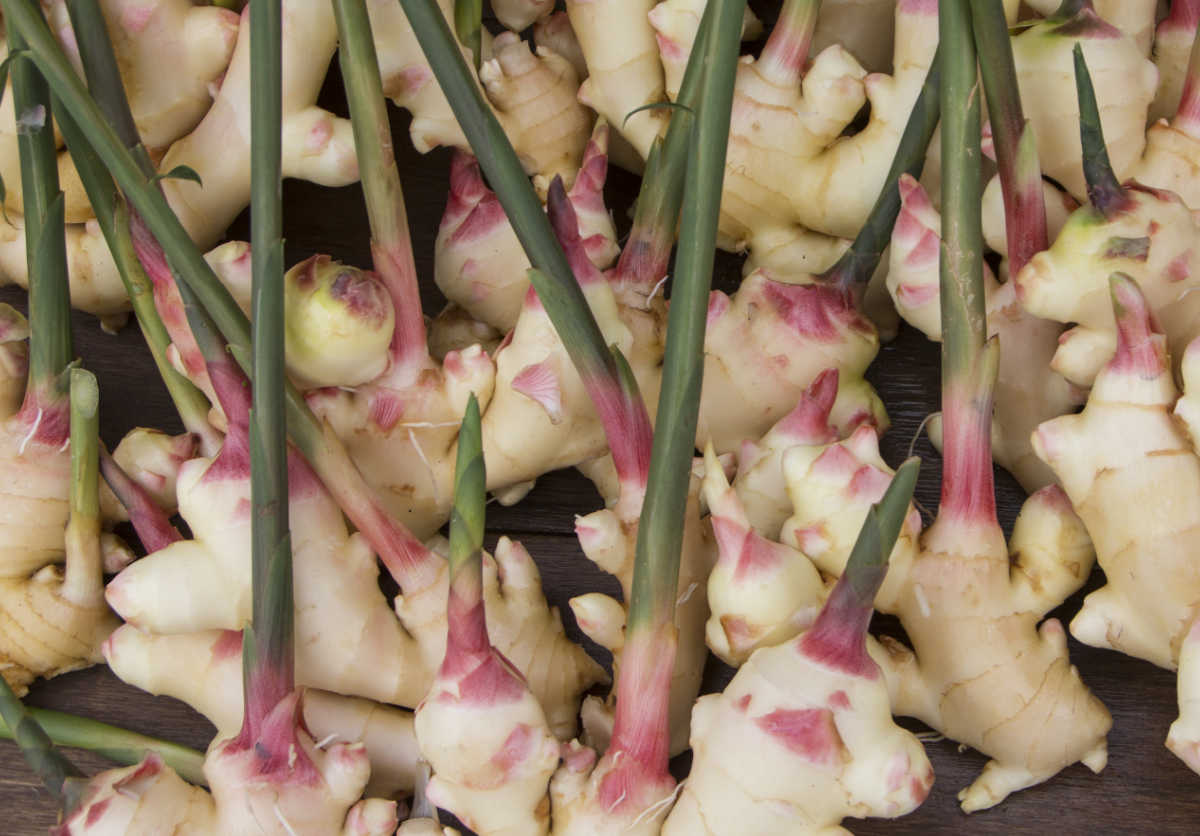
Ginger (Zingiber officinale)
Ginger is a moderately tender perennial herb. It can be grown, from rhizomes, in the ground in zones 9-12. It is also easily grown indoors in pots year-round.
- Leaf shape & texture: Narrow, lance-shaped, arching, bright green leaves
- Growth habit: Upright shoots, 2-4 feet (60-120 cm) tall
- Scent/aroma: Aromatic, strong, and spicy
- Flowers: Yellow-green flowers with purple accents
- Bloom time: Late summer to early fall
- Hardiness zones: USDA 9-12
- Culinary tip: It can be used in a variety of cuisines and often appears in stir fries, curries, and marinades.
- Growing guide: Learn how to grow ginger at home from ginger root.
Get ready-to-plant ginger rhizomes on Etsy.
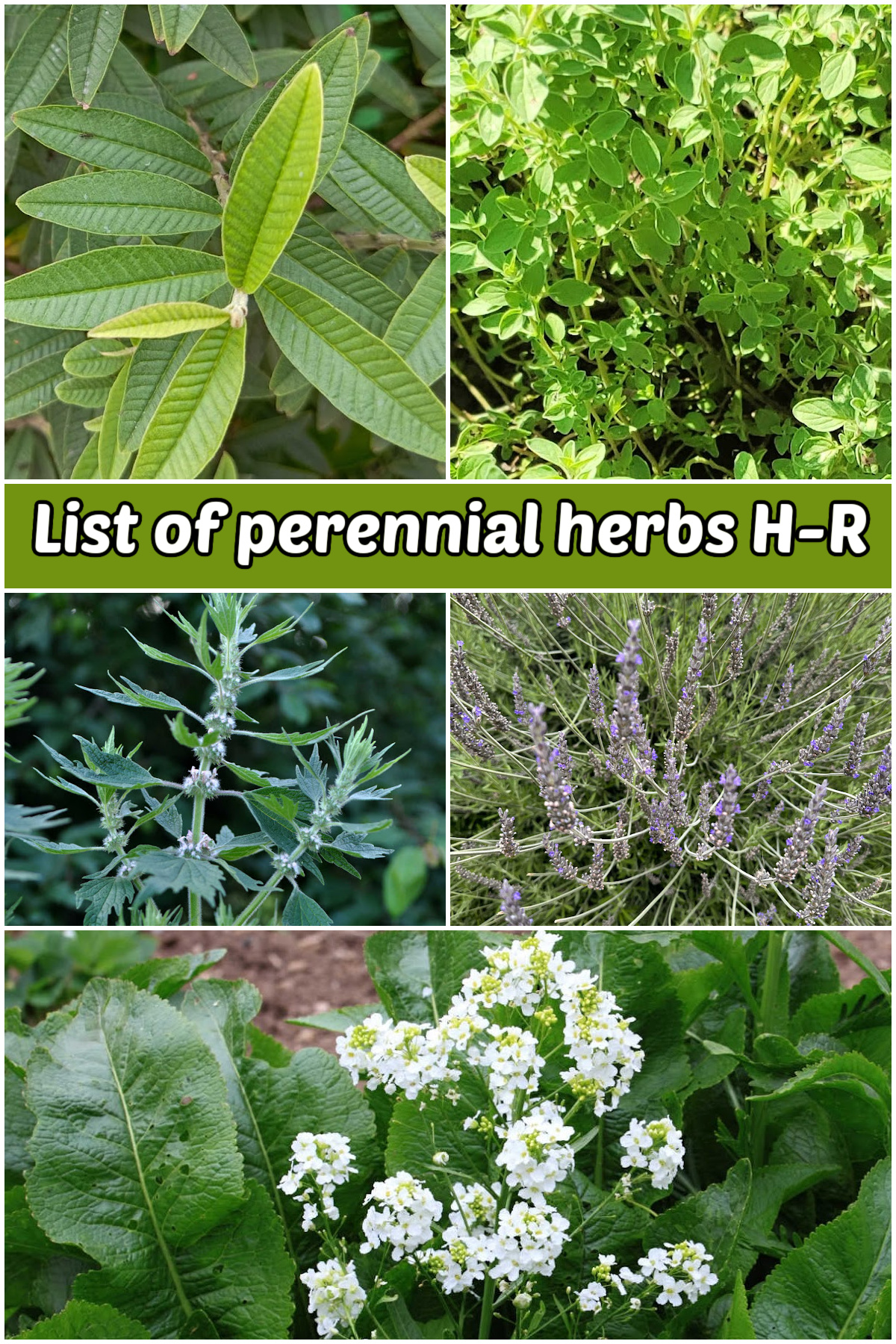
Perennial herb list H-R
The hardy perennial herbs in this section begin with the letters H-R.
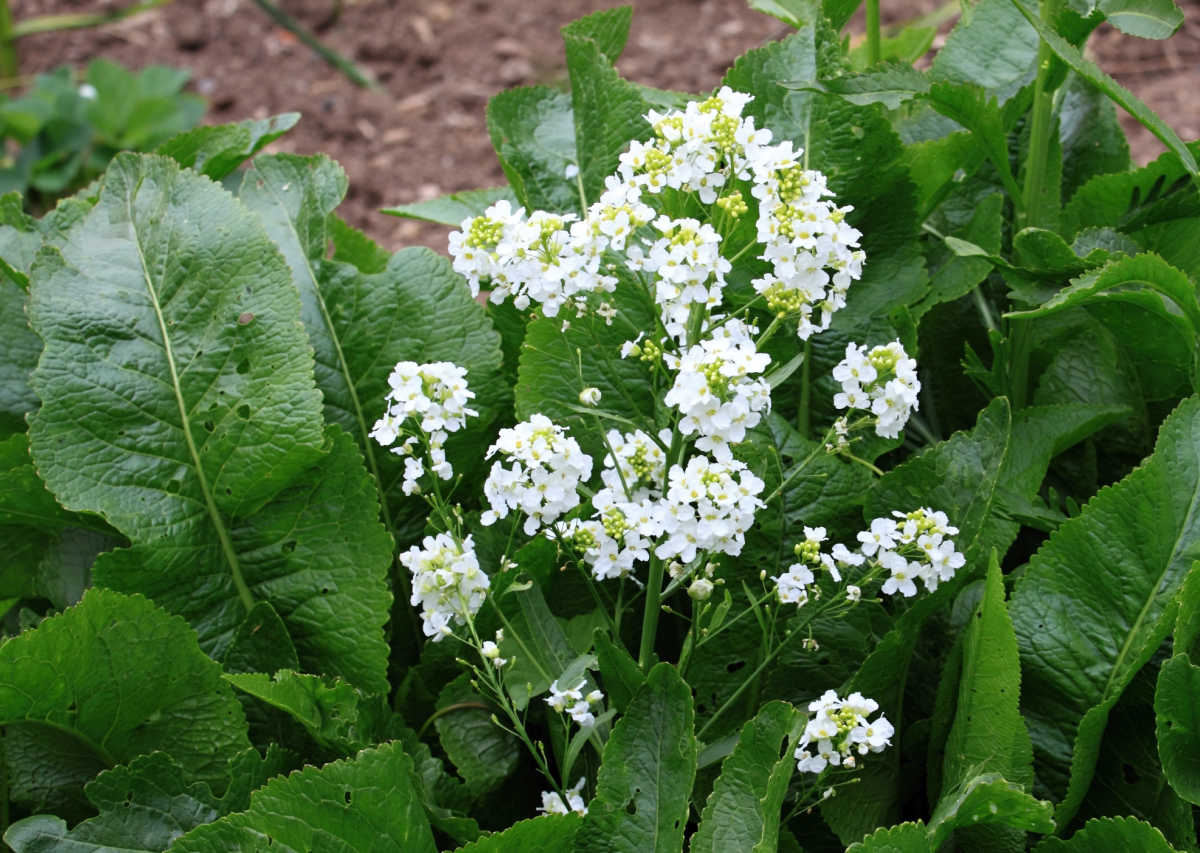
Horseradish (Armoracia rusticana)
The spicy flavor of horseradish sauce comes from the crushed roots of this edible herb.
- Leaf shape & texture: Large, coarse, bright green leaves with wavy edges
- Growth habit: Upright, clumps 2-2½ feet (60-75 cm) tall
- Scent/aroma: Pungent, sharp, and spicy
- Flowers: Small white flowers
- Bloom time: Early spring through summer
- Hardiness zones: USDA 4-8
- Culinary tip: Grate the roots of this edible herb to make condiments.
Get live horseradish plants here.
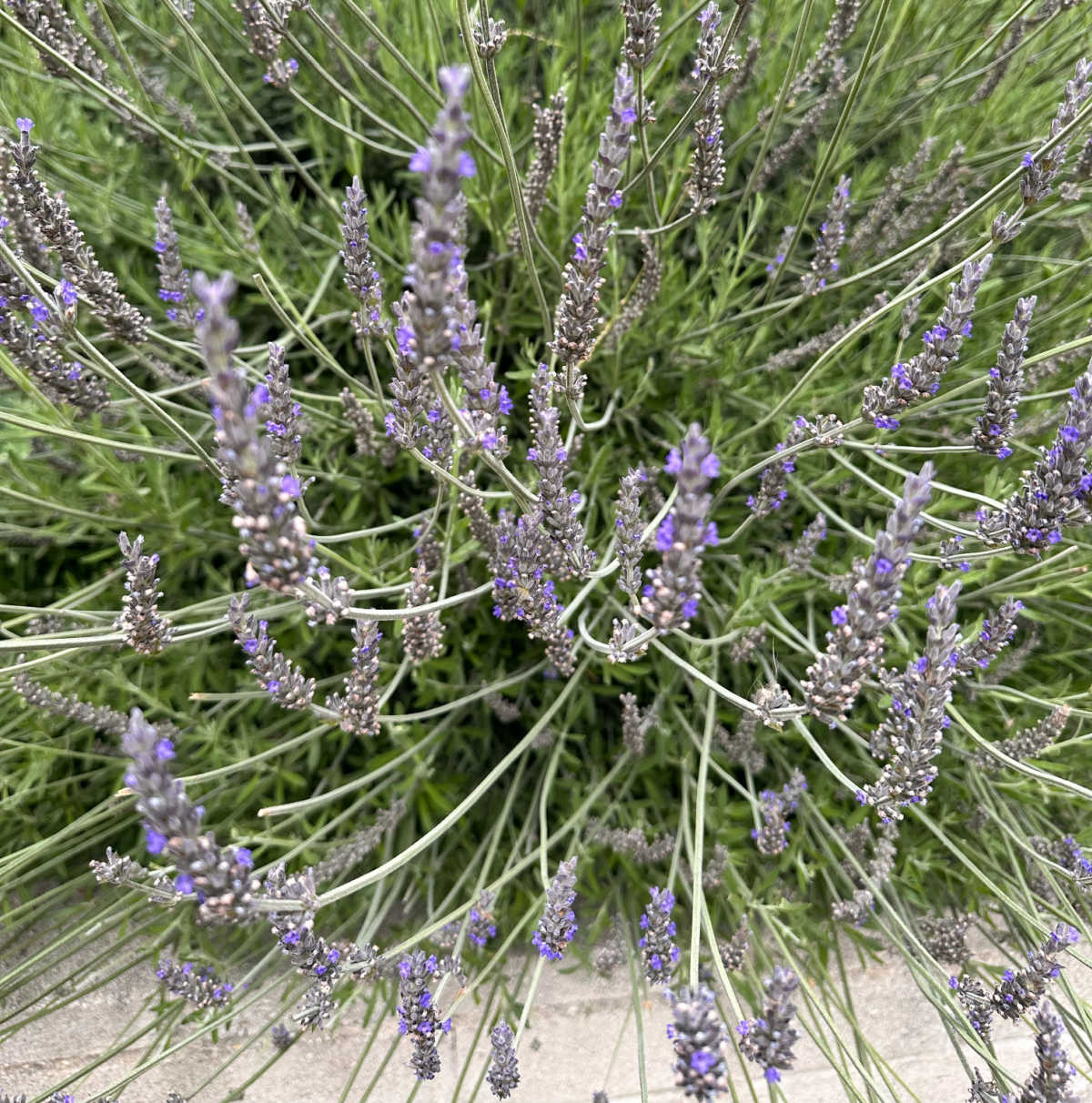
Lavender (Lavandula angustifolia)
This perennial herb is known for its fragrant leaves and purple flower spikes.
- Leaf shape & texture: Narrow, gray-green, fuzzy leaves
- Growth habit: Low, bushy mounds 1-3 feet (30-90 cm) tall
- Scent/aroma: Sweet, floral aroma
- Flowers: Purple flower spikes
- Bloom time: Late spring to mid-summer
- Hardiness zones: USDA 5-9
- Culinary tip: Lavender is strong, so use it sparingly in baked goods, teas, and syrups.
Purchase lavender plants here.
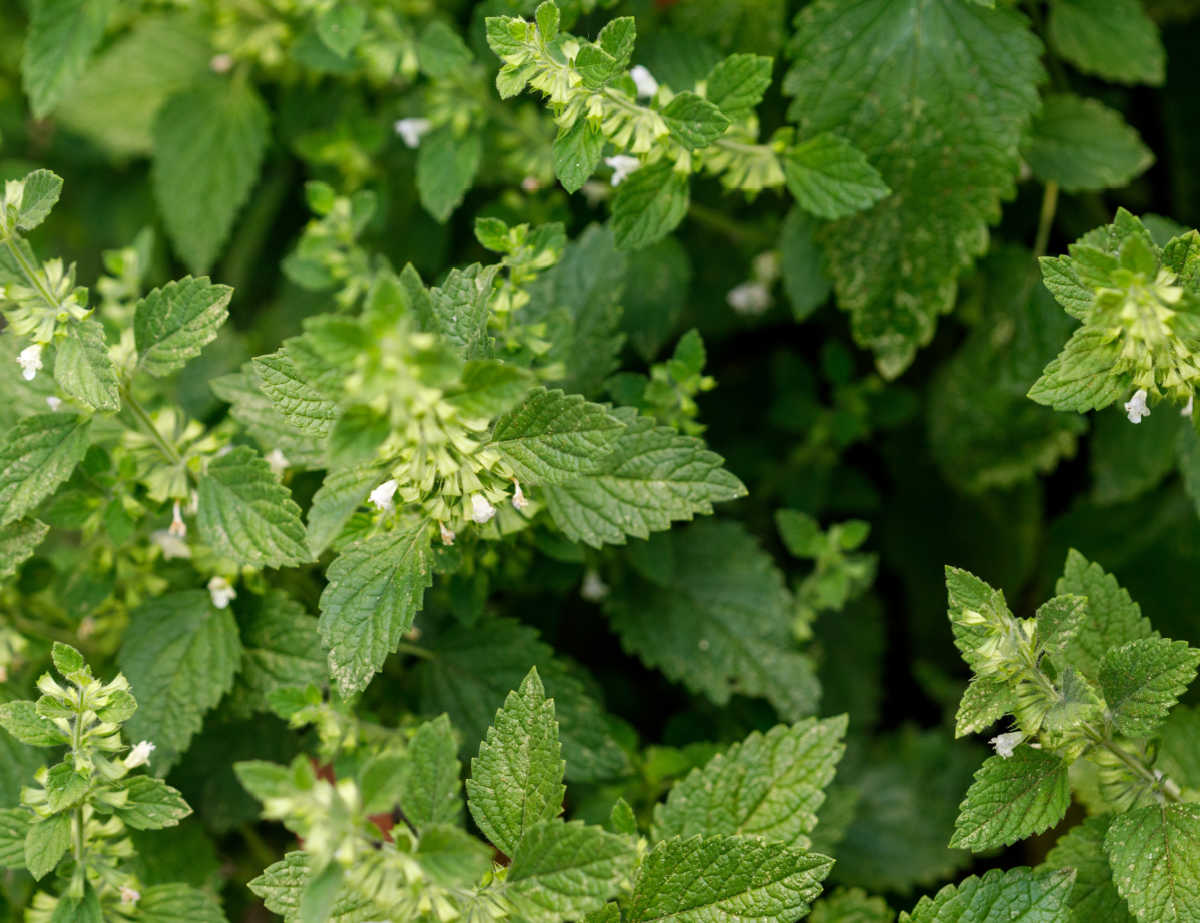
Lemon balm (Melissa officinalis)
The delicate leaves of lemon balm will lose their flavor if they are overcooked. They are best used fresh to add a lemon flavor to cold dishes.
- Leaf shape & texture: Heart-shaped, wrinkled leaves
- Growth habit: Upright clumps, 2-3 feet (60-90 cm) tall
- Scent/aroma: Strong lemony fragrance
- Flowers: White or pale yellow flowers
- Bloom time: Late spring to late summer
- Hardiness zones: USDA 3-7
- Culinary tip: Add lemon balm as a garnish to desserts like sorbets, fruit salads and panna cottas.
Start growing this culinary herb in your garden.
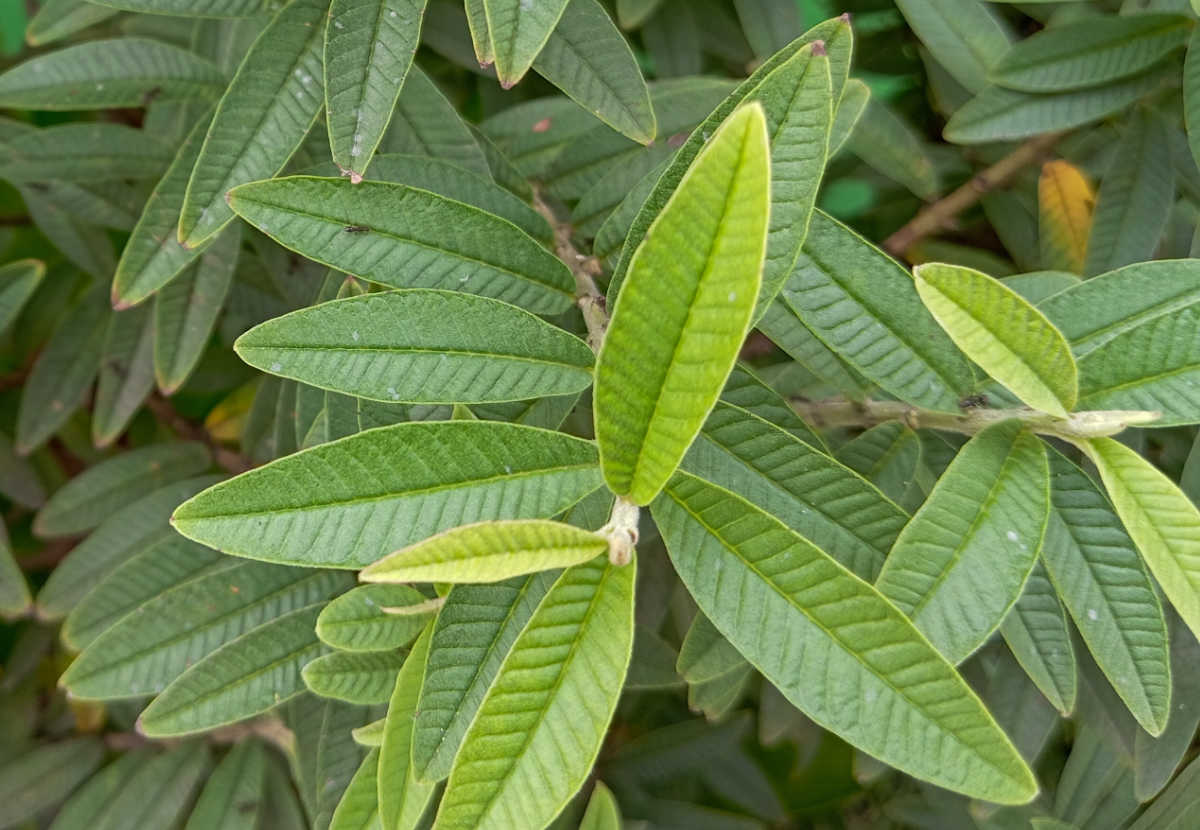
Lemon verbena (Aloysia citrodora)
This edible perennial herb’s strong lemony scent can act as a natural mosquito repellent.
- Leaf shape & texture: Long and narrow, pointed, bright green leaves
- Growth habit: Shrub, 3-6 feet (90-180 cm) tall
- Scent/aroma: Strong lemon scent
- Flowers: Small white flowers
- Bloom time: Midsummer to early fall
- Hardiness zones: USDA 8-11
- Culinary tip: It can be used as a substitute for lemongrass.
Find lemon verbena plants here.
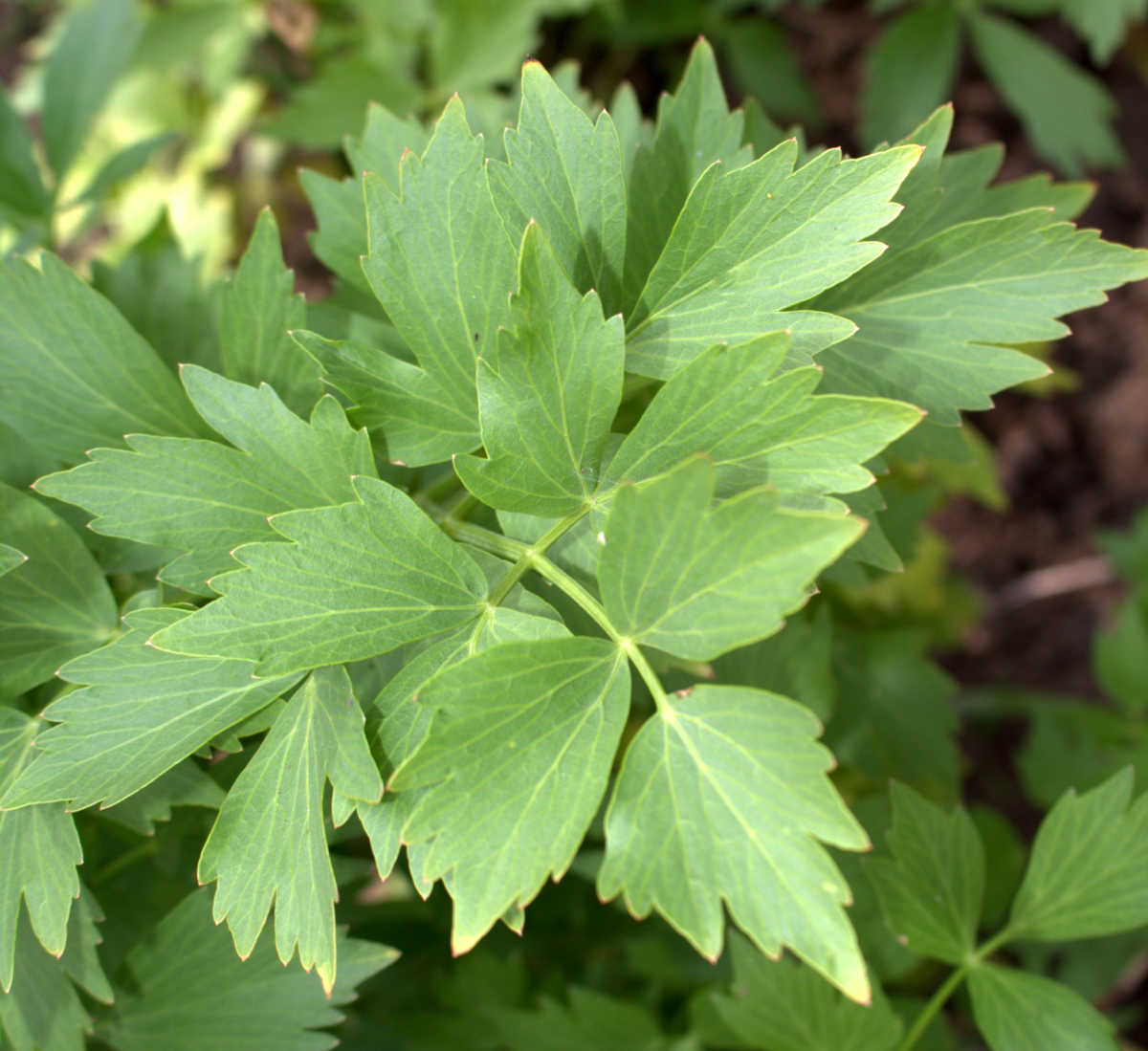
Lovage (Levisticum officinale)
This hardy perennial herb is also known as “love parsley”. Even though it looks like parsley, it has a flavor more similar celery.
- Leaf shape & texture: Large, glossy, divided leaves
- Growth habit: Upright, 4-8 feet (120-240 cm) tall
- Scent/aroma: Celery-like aroma
- Flowers: Greenish-yellow flowers
- Bloom time: Late spring to early summer
- Hardiness zones: USDA 4-8
- Culinary tip: Use the leaves and stems to flavor soups and stews.
Shop for lovage plants on Etsy.
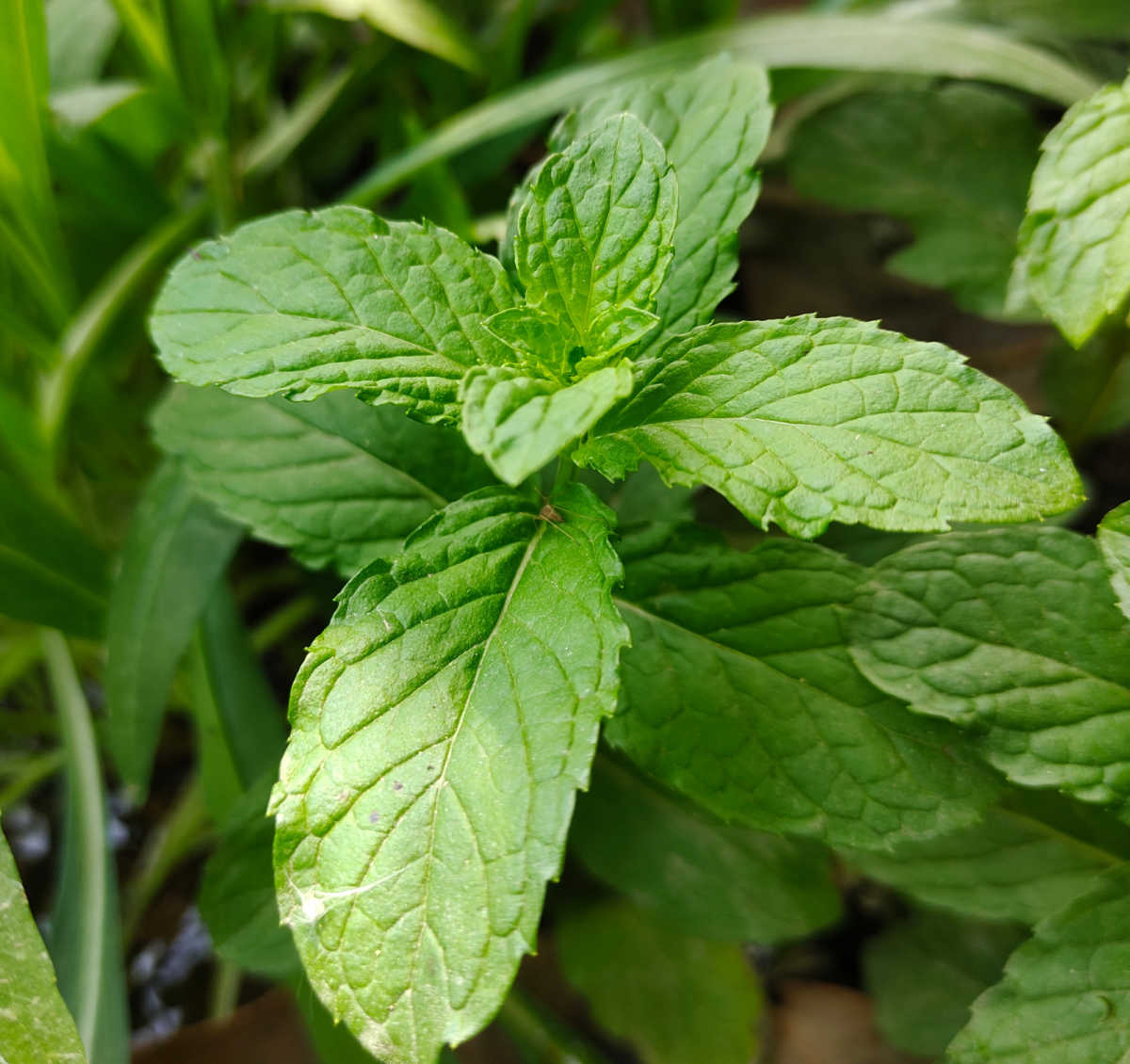
Mint (Mentha spp.)
This hardy herb has been cultivated for thousands of years and comes in many varieties, like chocolate mint and orange mint.
- Leaf shape & texture: Bright green, oval to lance-shaped with serrated edges
- Growth habit: Spreads vigorously, 12 to 18 inches (30-45 cm) tall
- Scent/aroma: Strong menthol fragrance
- Flowers: Small, tubular white, pink or purple clusters on spikes
- Bloom time: Mid to late summer
- Hardiness zones: USDA 3-11, depending on the variety
- Culinary tip: Mint is a versatile herb that can brighten drinks, desserts, sauces, and savory dishes.
Shop Etsy for a variety of mint plants.
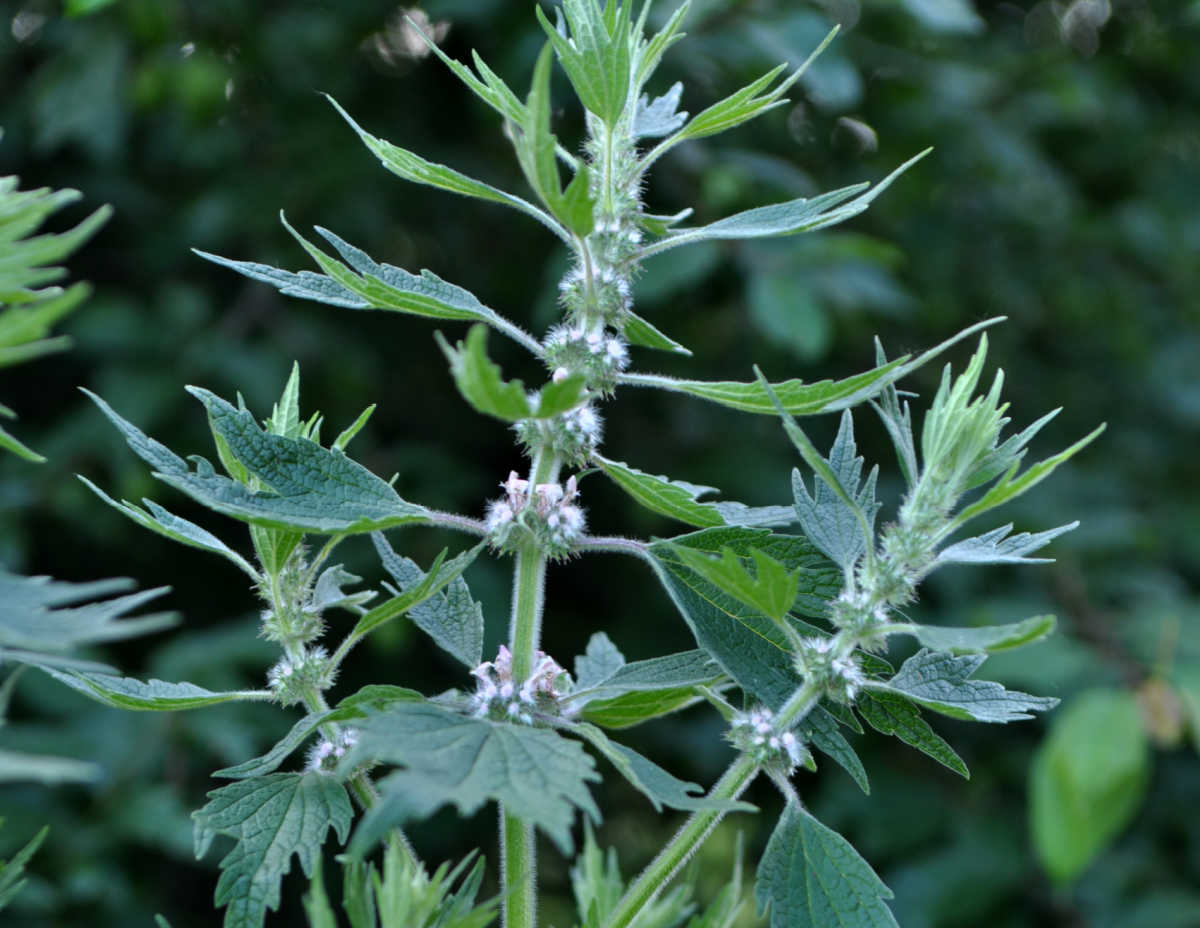
Motherwort (Leonurus cardiaca)
This perennial herb’s common name originates from its traditional use as a calming agent for mothers after childbirth.
- Leaf shape & texture: Deeply lobed, gray-green, hairy leaves with serrated edges
- Growth habit: Upright clumps, 2-5 feet (60-150 cm) tall
- Scent/aroma: Bitter, pungent aroma
- Flowers: Pink to light purple flowers
- Bloom time: Mid to late summer
- Hardiness zones: USDA 3-8
- Culinary tip: Since motherwort has a strong, bitter flavor, it is used primarily as a medicinal herb.
Find seeds for the medicinal herb motherwort here.
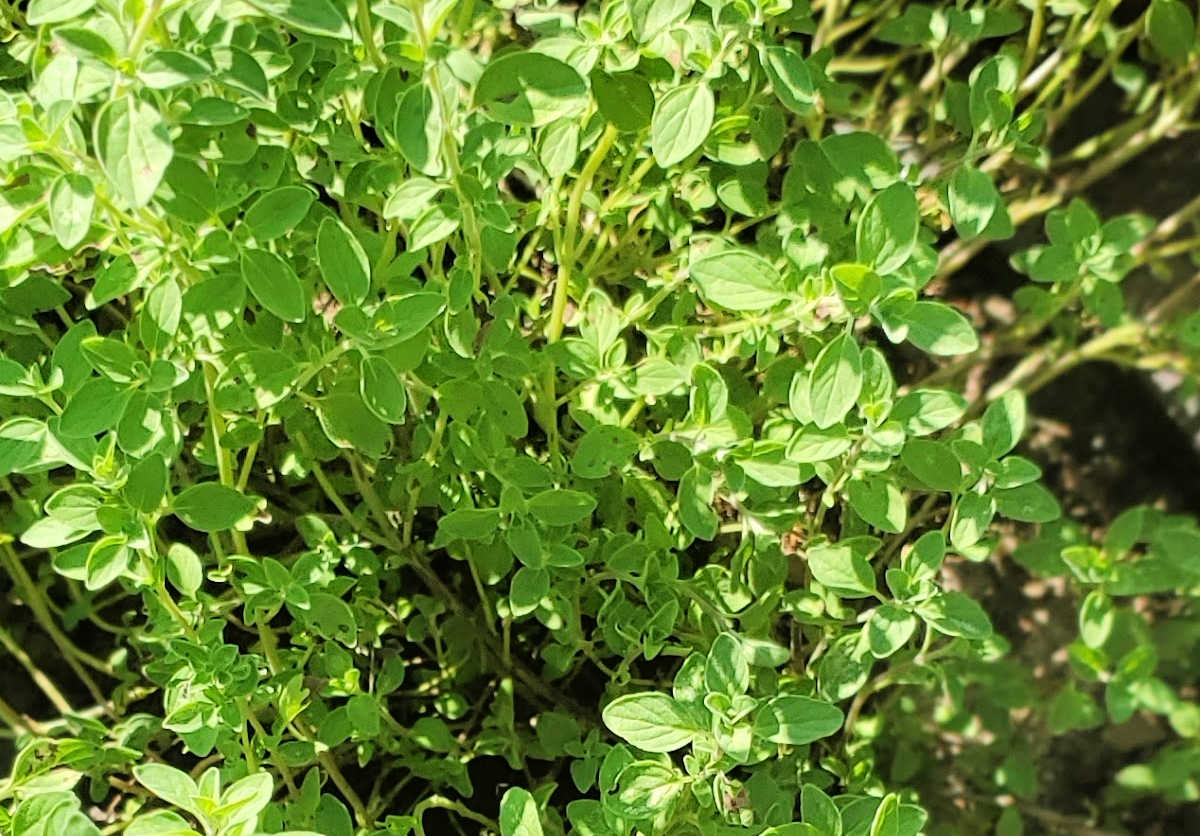
Oregano (Origanum vulgare)
The perennial culinary herb is often used to make a bouquet garni to flavor soups and stews.
- Leaf shape & texture: Small, oval leaves
- Growth habit: Low, spreading, 1-2 feet (30-60 cm) tall
- Scent/aroma: Strong, warm with a slightly spicy scent
- Flowers: Purple to pink flower spikes
- Bloom time: Mid to late summer
- Hardiness zones: Cold-hardy in USDA zones 4-10
- Culinary tip: This edible herb is a classic seasoning for Italian and Mediterranean dishes.
- Growing guide: Learn how to grow oregano.
Purchase oregano for your garden on Etsy.
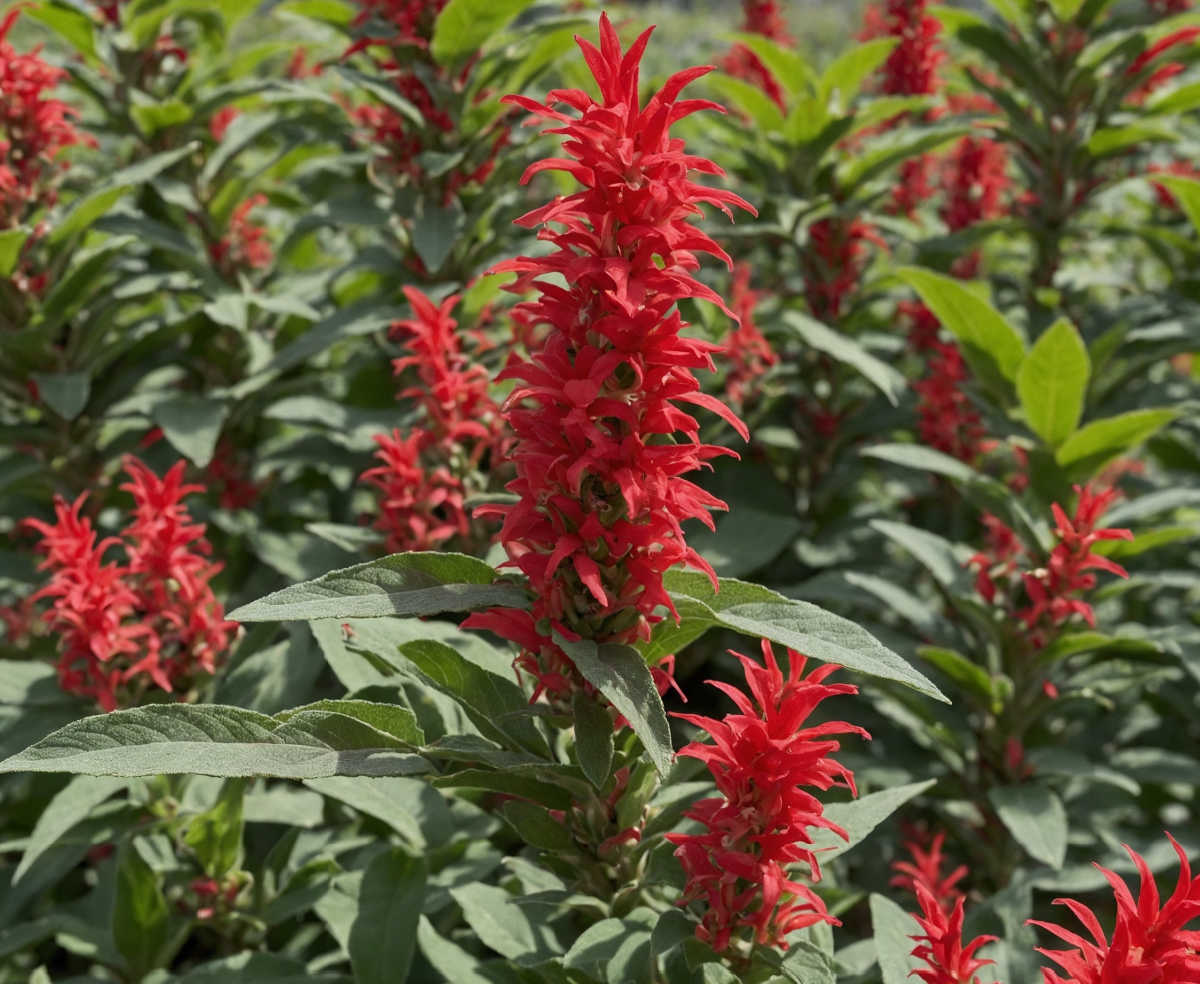
Pineapple sage (Salvia elegans)
The bright flowers of pineapple sage attract pollinators like hummingbirds and butterflies.
- Leaf shape & texture: Lance-shaped, soft and slightly serrated
- Growth habit: Upright, sprawling, grows 3-5 feet (90-150 cm) tall
- Scent/aroma: Sweet, fruity smell reminiscent of pineapple
- Flowers: Bright red tubular flowers
- Bloom time: Late summer to fall
- Hardiness zones: USDA 8-11
- Culinary tip: The leaves add a sweet, fruity flavor to teas, salads, and desserts. The flowers are also edible.
Get pineapple sage plants here.
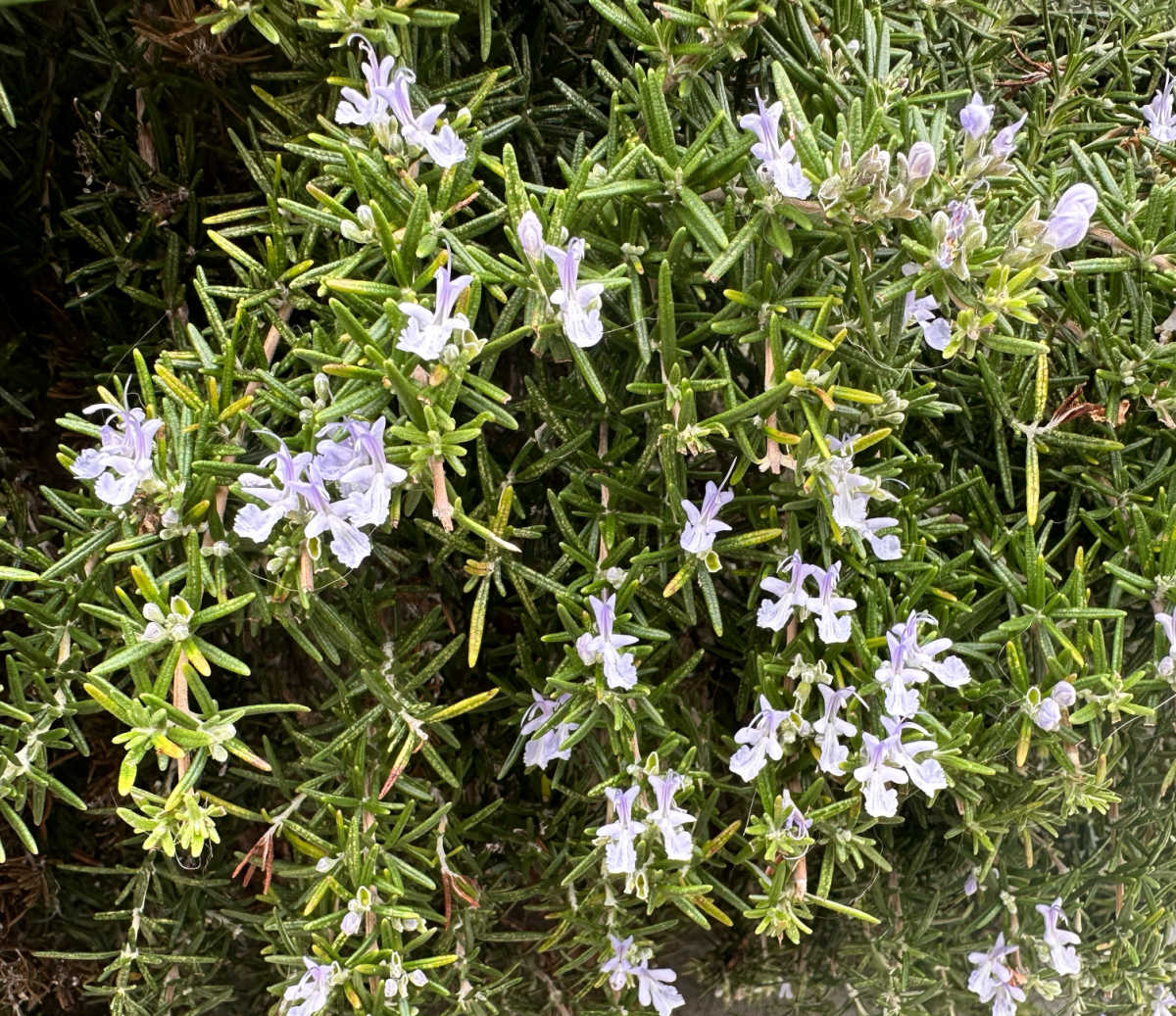
Rosemary (Salvia rosmarinus)
This edible perennial herb is very popular in France and Italy. French rosemary is distinctive because of the mix of pine and mint in its flavor notes.
- Leaf shape & texture: Narrow, dark green, needle-like leaves
- Growth habit: Upright, 2-5 feet (60-150 cm) tall
- Scent/aroma: Pine-like aroma
- Flowers: Pale blue flowers
- Bloom time: Late spring to early summer
- Hardiness zones: Cold-hardy in zones 8-10
- Culinary tip: Use rosemary to flavor roasted meats, vegetables, and bread.
- Growing guide: See tips for growing rosemary here.
Shop for rosemary plants on Etsy.
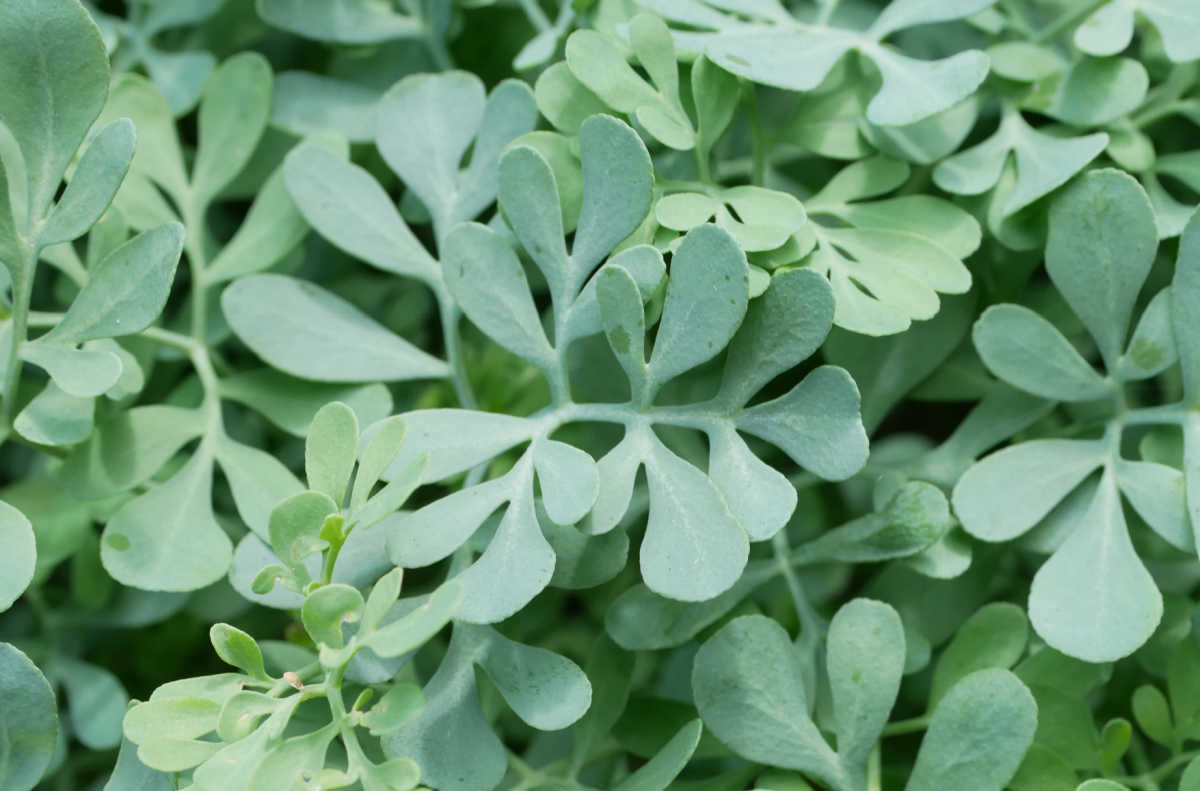
Rue (Ruta graveolens)
This medicinal perennial herb has a long history of use in traditional and herbal medicine.
- Leaf shape & texture: Blue-green and fern-like
- Growth habit: Upright, woody, bushy clumps 2-3 feet (60-90 cm) tall
- Scent/aroma: Strong, bitter, and pungent smell
- Flowers: Small yellow star-shaped flowers
- Bloom time: Late spring to early summer
- Hardiness zones: USDA 4-9
- Culinary tip: In Italy, rue is used in the production of the alcoholic beverage grappa.
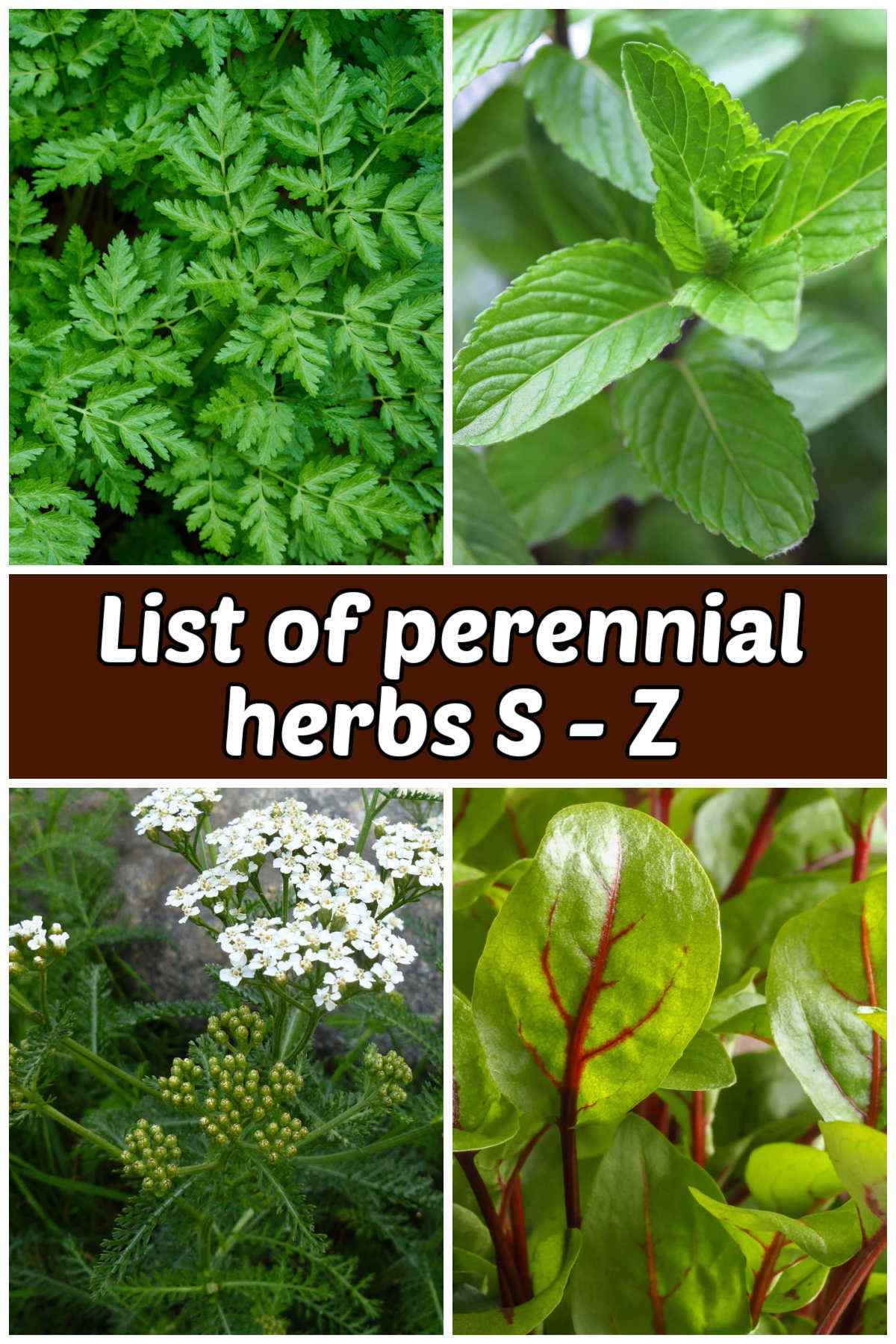
List of perennial herbs S-Z
These hardy perennial herbs all begin with the letters S-Z.
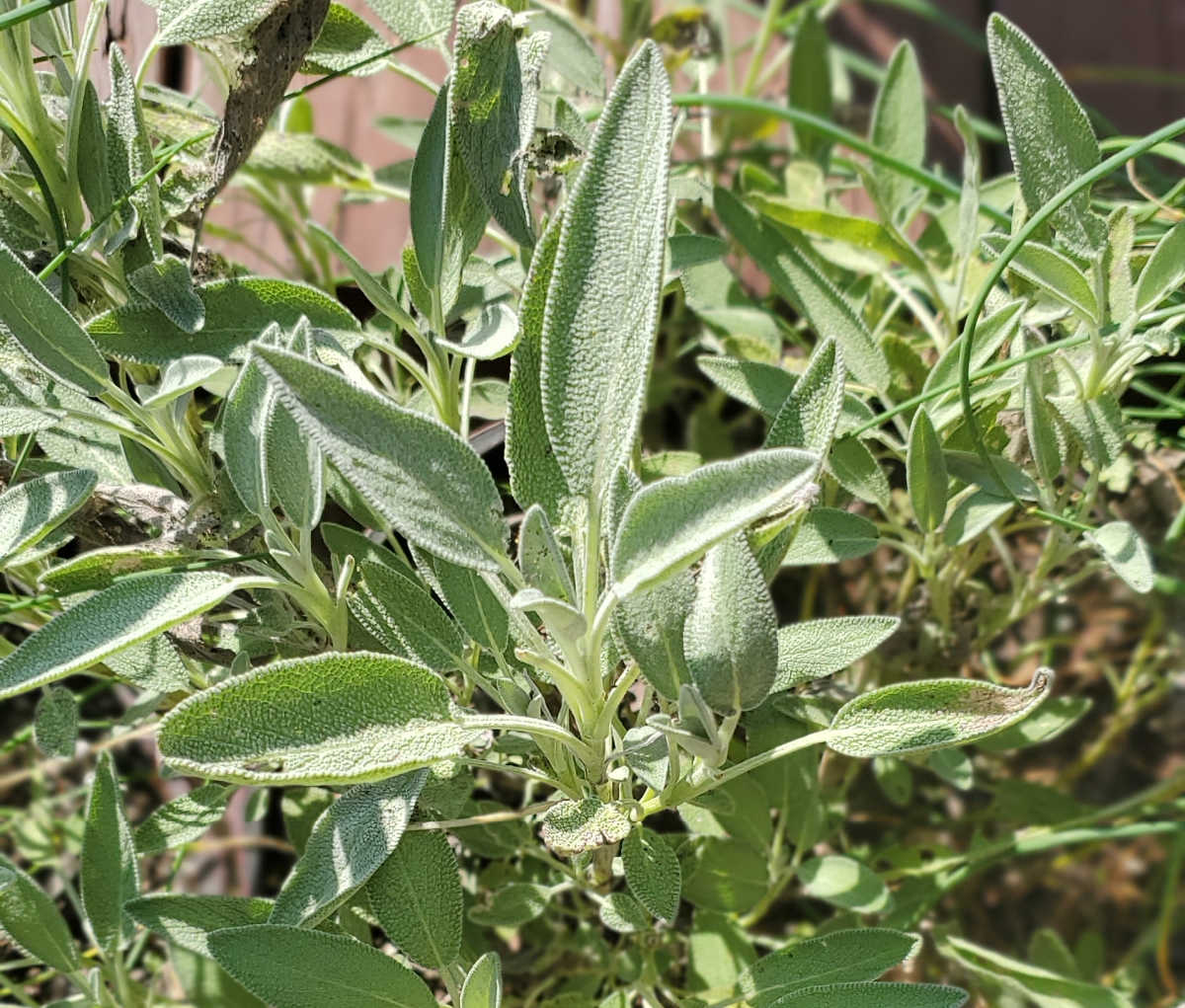
Sage (Salvia officinalis)
The botanical name of sage derives from the Latin word salvere, meaning “to heal.” This hardy herb has both culinary and medical uses.
- Leaf shape & texture: Soft, fuzzy, gray-green leaves
- Growth habit: Low and bushy, 1-2 feet (30-60 cm) tall
- Scent/aroma: Strong, earthy aroma
- Flowers: Purple or blue flowers
- Bloom time: Late spring to early fall
- Hardiness zones: USDA 4-9, depending on variety
- Culinary tip: Sage pairs best with rich meats like pork, turkey, and game meat.
- Growing guide: Learn how to grow and care for sage plants here.
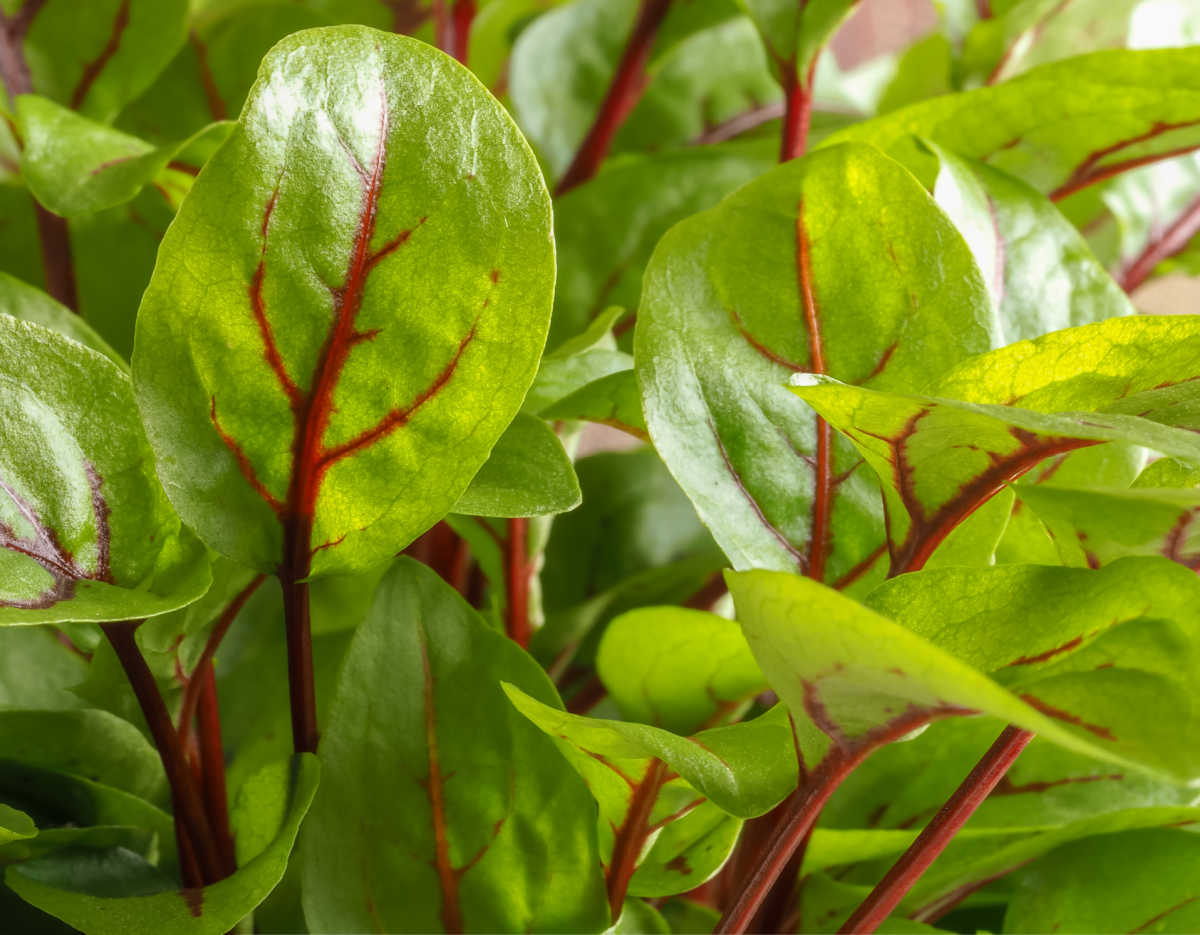
Sorrel (Rumex acetosa ‘Red Veined’)
Although sorrel is widely used as a culinary herb, it should be used in moderation due to its natural oxalates, especially if you are prone to kidney stones.
- Leaf shape & texture: Medium green leaves with red veins
- Growth habit: Low clumps, 1-2 feet (30-60 cm) tall
- Scent/aroma: Lightly tangy lemon aroma
- Flowers: Small greenish-white flowers
- Bloom time: Spring through early fall
- Hardiness zones: USDA 3-8
- Culinary tip: Add the tart flavor of sorrel to fatty fish dishes, eggs, or grains.
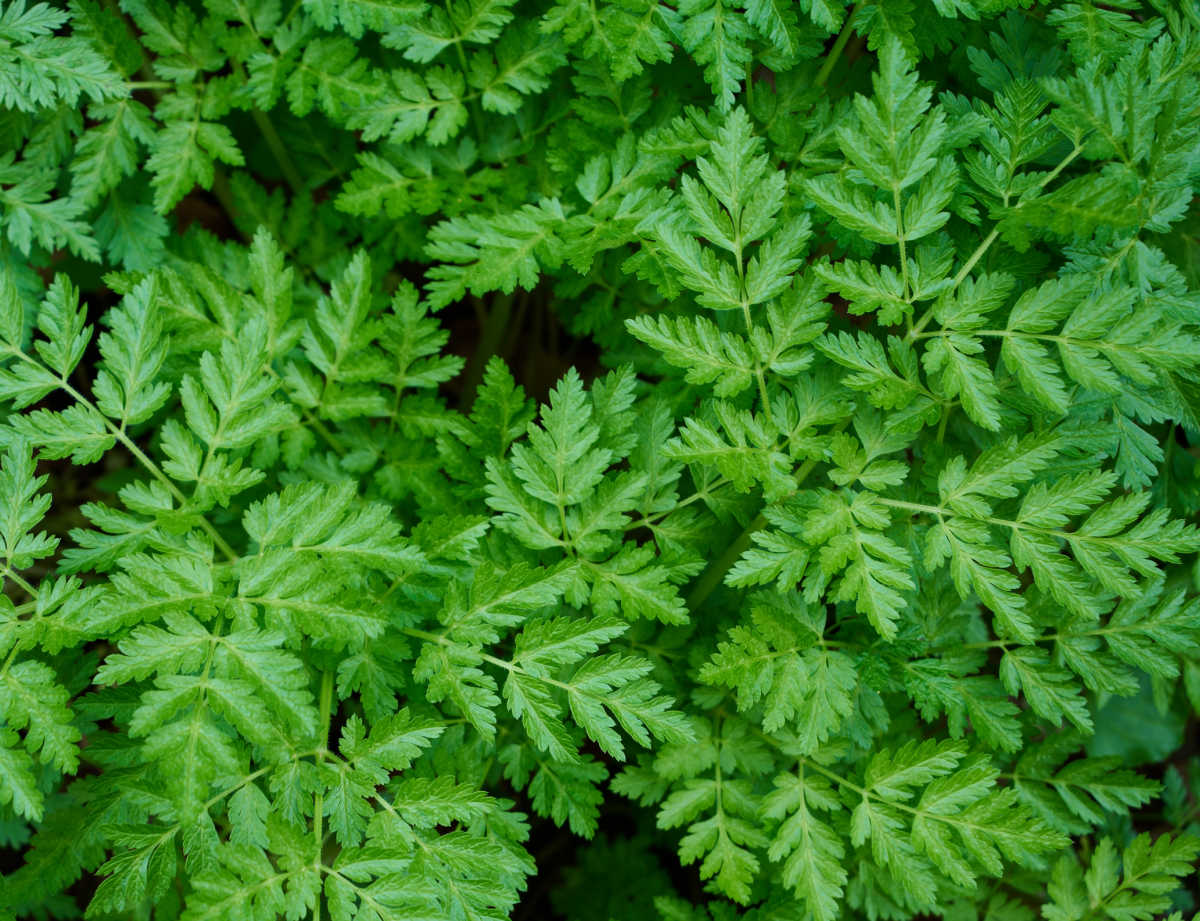
Sweet cicely (Myrrhis odorata)
The seeds of sweet cicely were once coated in sugar and sold in Europe as a natural candy.
- Leaf shape & texture: Feather-shaped green leaves with a hairy underside
- Growth habit: Upright, 2-3 feet (60-90 cm) tall
- Scent/aroma: Anise-like scent
- Flowers: Small white flowers
- Bloom time: Late spring to early summer
- Hardiness zones: USDA 3-7
- Culinary tip: Use sweet cicely leaves and seeds to add a natural sweetness to fruit dishes.
Purchase seeds for sweet cicely here.
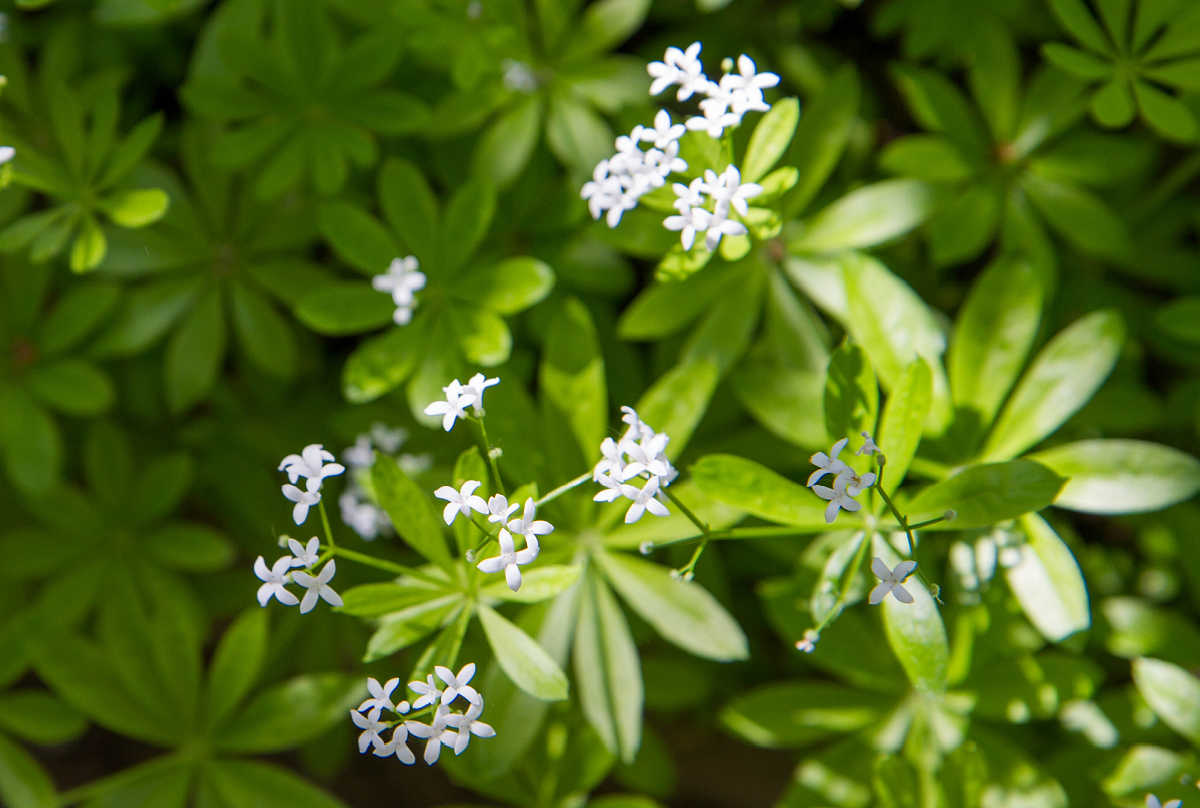
Sweet woodruff (Galium odoratum)
This perennial herb has been used since medieval times to scent linens.
- Leaf shape & texture: Whorls of slender, lance-shaped green leaves
- Growth habit: Low-growing, spreading groundcover, 6-18 inches (15-45 cm) tall
- Scent/aroma: Fresh hay-like fragrance
- Flowers: Tiny, star-shaped flowers
- Bloom time: Spring to early summer
- Hardiness zones: USDA 4-8
- Culinary tip: Sweet woodruff is a medicinal herb that is only considered safe for consumption by the FDA in alcoholic beverages.
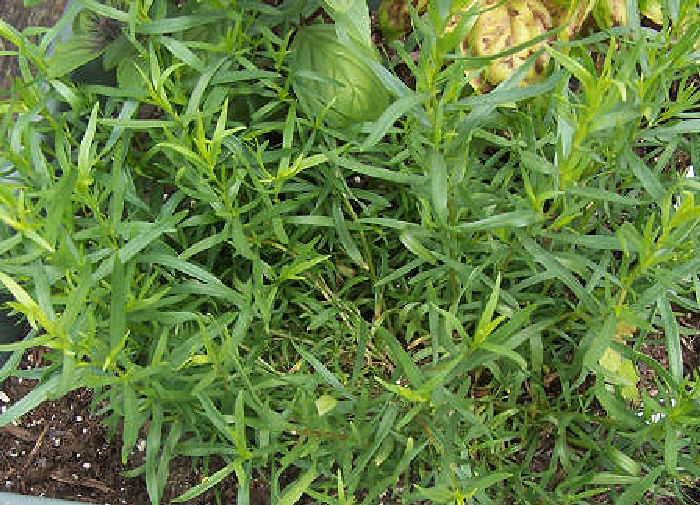
Tarragon (Artemisia dracunculus)
The botanical name of tarragon comes from the Latin dracunculus (“little dragon”), due to the root’s twisting shape.
- Leaf shape & texture: Narrow, smooth, bright green leaves
- Growth habit: Upright clumps, 2-3 feet (60-90 cm) tall
- Scent/aroma: Sweet, anise-like aroma
- Flowers: Small, greenish-yellow flowers
- Bloom time: Mid to late summer
- Hardiness zones: Cold-hardy in zones 3-9, depending on variety
- Culinary tip: Tarragon is perfect to use in sauces, dressings, and fish recipes.
- Growing guide: Get tips for growing tarragon here.
Shop for tarragon plants and seeds on Etsy.
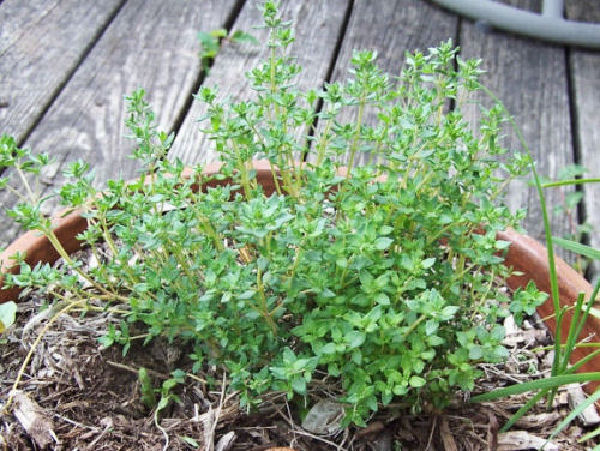
Thyme (Thymus vulgaris)
Ancient Egyptians used thyme for embalming, while Greeks burned it as a form of incense. It is widely used in Mediterranean cooking.
- Leaf shape & texture: Small, oval gray-green leaves
- Growth habit: Low, spreading, 6-12 inches (15-30 cm) tall
- Scent/aroma: Warm, earthy aroma
- Flowers: Pink, white, or purple flowers
- Bloom time: Summer
- Hardiness zones: USDA 5-9
- Culinary tip: Thyme is often used with rosemary and garlic to butter-baste steak.
- Growing guide: Get tips for growing thyme here.
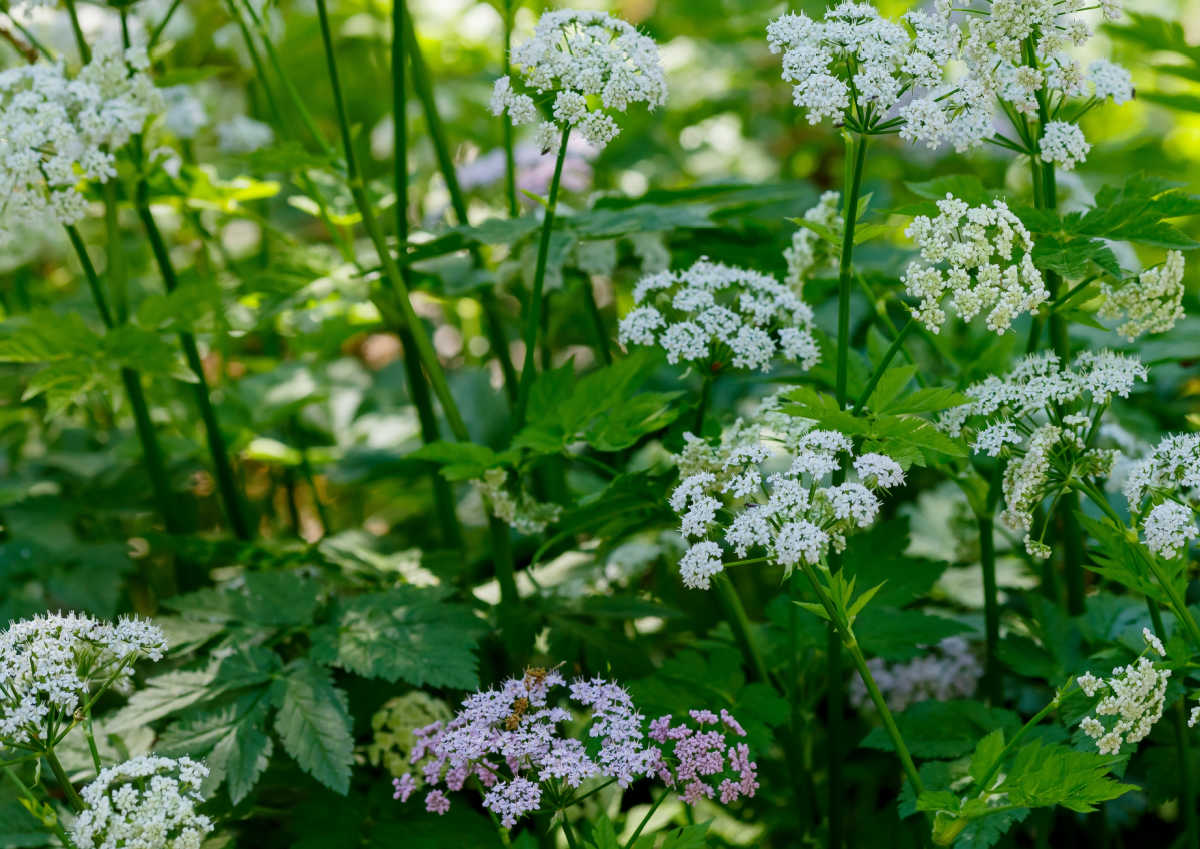
Valerian (Valeriana officinalis)
Valerian is considered a medicinal herb. Its roots have been used for centuries as a natural sedative and sleep aid.
- Leaf shape & texture: Bright green, fern-like leaves
- Growth habit: Upright clumps, 3-5 feet (90-150 cm) tall
- Scent/aroma: Strong, earthy scent from the roots; leaves and stems are mildly aromatic
- Flowers: Small white or pale pink flowers
- Bloom time: Late spring to fall
- Hardiness zones: USDA 4-7
- Culinary tip: Valerian is not often used in cooking. The roots contain sedative compounds and are used as a natural sleep aid.
Get seeds to grow the medicinal herb valerian here.
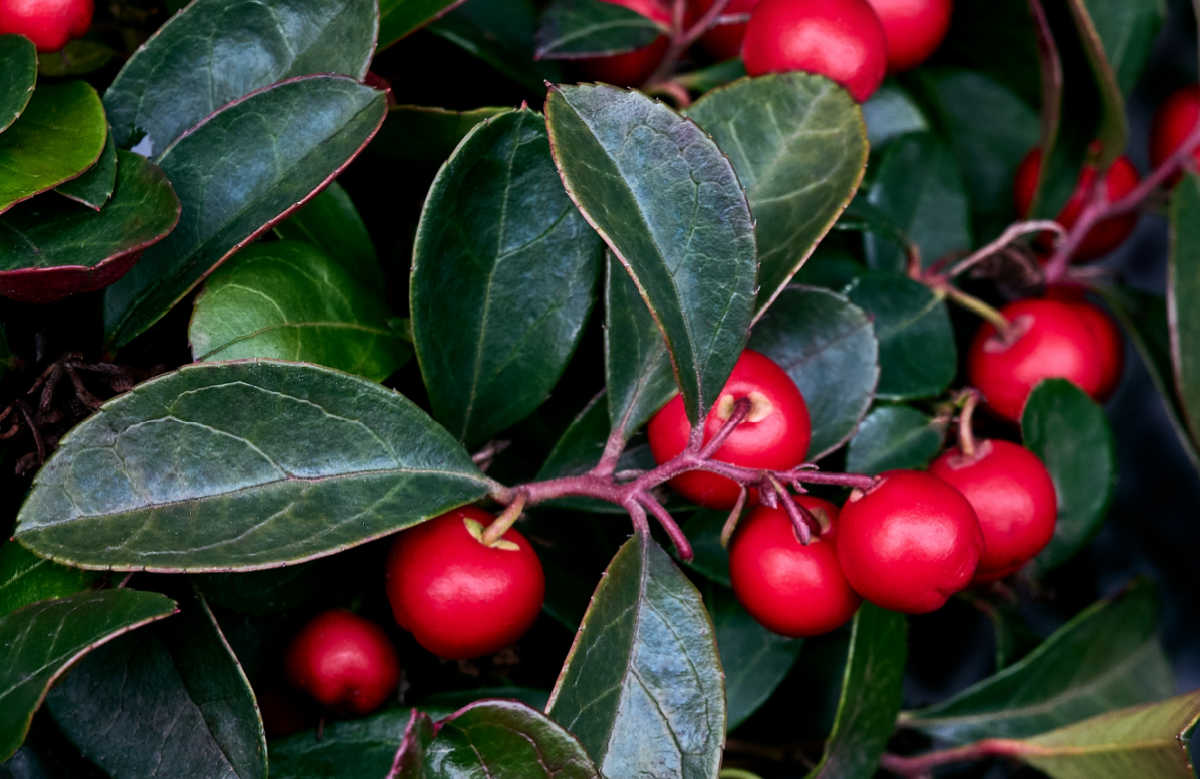
Wintergreen (Gaultheria procumbens)
This perennial herb produces berries that last into the cooler months, providing food for birds and winter interest for gardens.
- Leaf shape & texture: Small, glossy, dark green leaves
- Growth habit: Low-growing and creeping, 6-12 inches (15-30 cm) tall
- Scent/aroma: Strong, mint-like aroma
- Flowers: Small, white to pink flowers (and red berries in fall and winter)
- Bloom time: Late spring
- Hardiness zones: USDA 3-9
- Culinary tip: Wintergreen is often used to make commercial candy and syrups, but not frequently used in home cooking.
Shop wintergreen plants on Etsy.
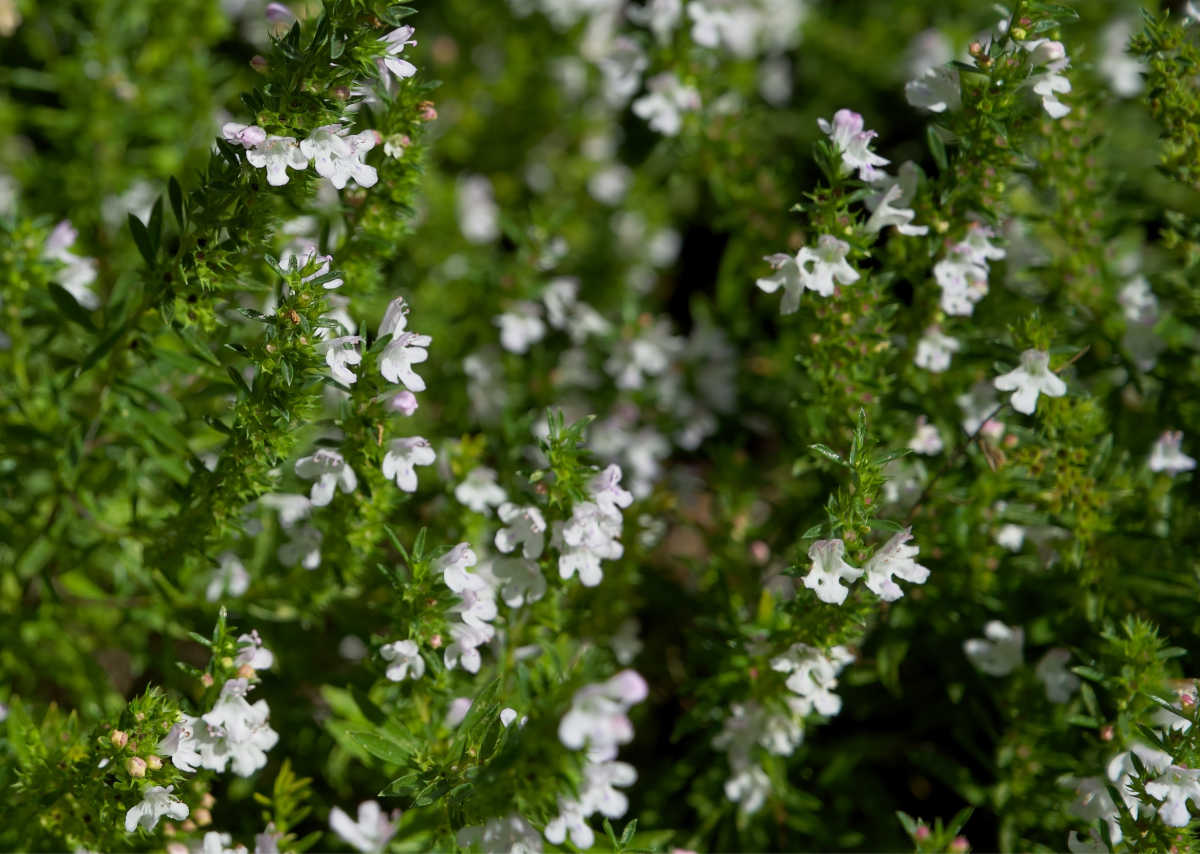
Winter savory (Satureja montana)
The Germans called this perennial herb a “bean herb” because of its ability to make beans easier to digest.
- Leaf shape & texture: Small, narrow, dark green leaves
- Growth habit: Low, spreading, 6-12 inches (15-30 cm) tall
- Scent/aroma: Strong, peppery aroma
- Flowers: White to pale lilac flowers
- Bloom time: Summer
- Hardiness zones: USDA 5-8
- Culinary tip: Use winter savory in bean dishes, stews, and with roasted vegetables.
Buy seeds to grow winter savory on Etsy.
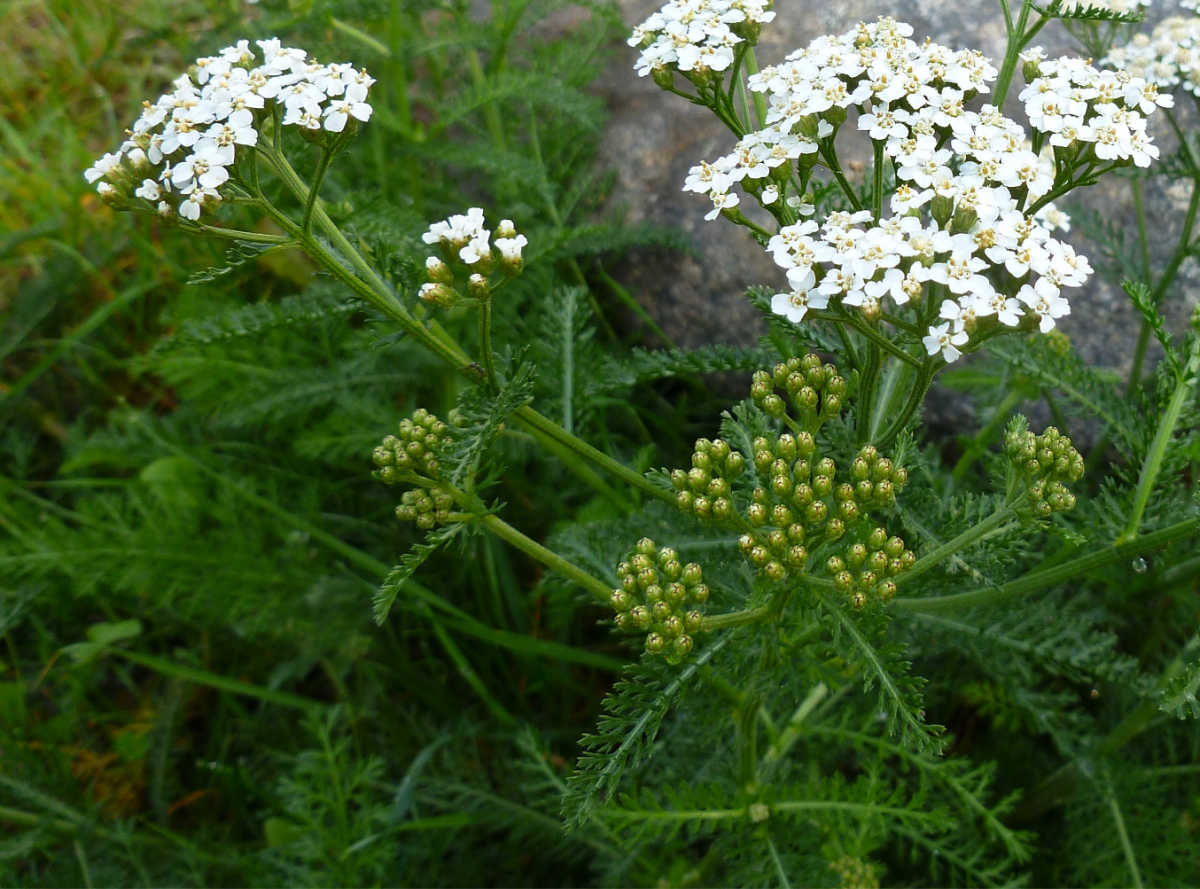
Yarrow (Achillea millefolium)
The medicinal herb yarrow is a nice addition to a pollinator garden, because its flowers attract bees, butterflies, and other insects.
- Leaf shape & texture: Feathery dark green leaves
- Growth habit: Upright clumps, 1-3 feet (30-90 cm) tall
- Scent/aroma: Light herbal scent
- Flowers: White, pink, or yellow flower clusters
- Bloom time: Spring to late summer
- Hardiness zones: USDA 3-9
- Culinary tip: Yarrow has a bitter taste. Use it sparingly in salads.
Get seeds for the perennial herb yarrow for your garden here.
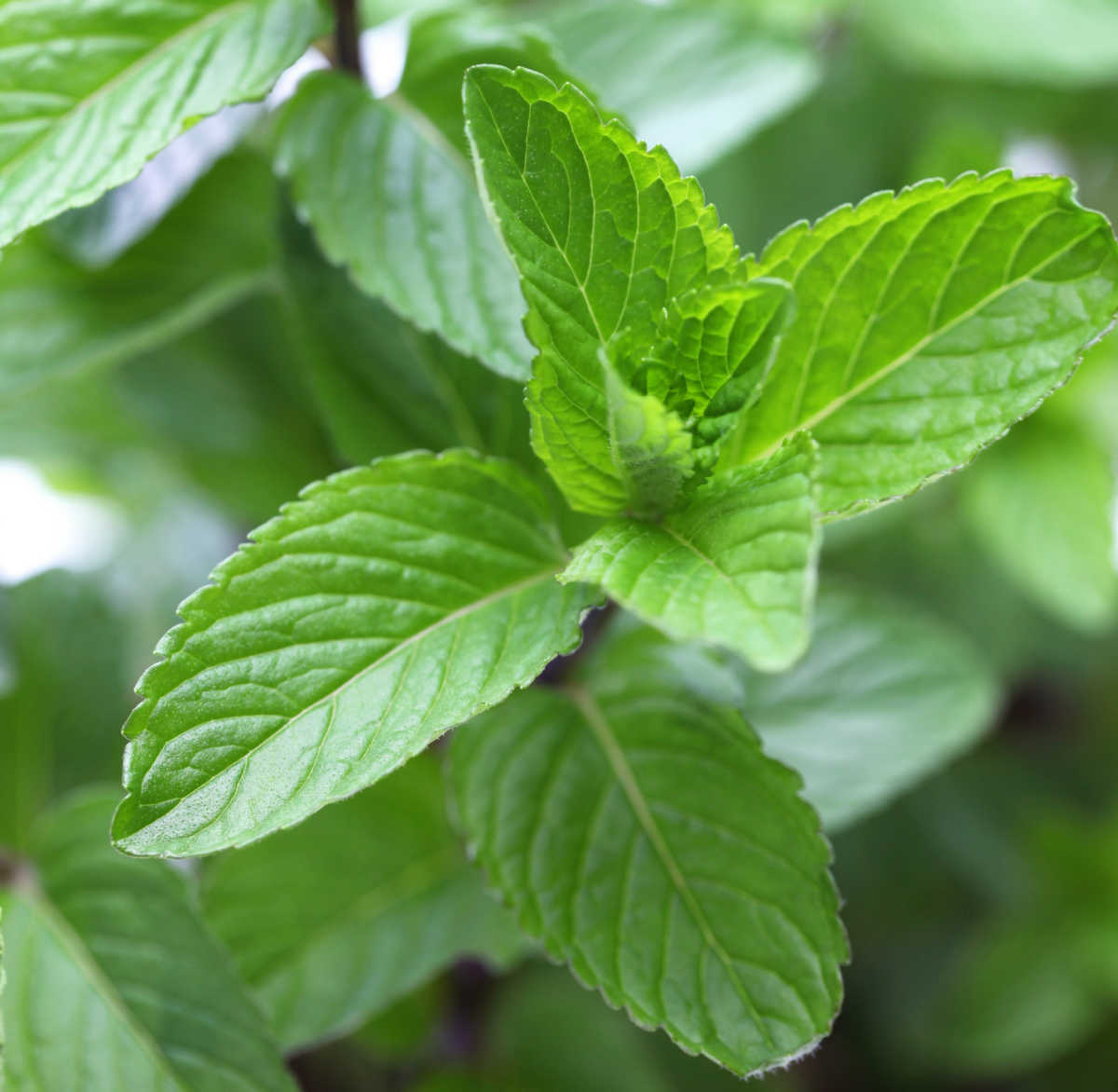
Yerba buena (Clinopodium douglasii, formerly Satureja douglasii)
The Spanish words yerba buena mean “good herb”. Californians originally named San Francisco Yerba Buena because this medicinal herb grew abundantly in the area.
- Leaf shape & texture: Small oval, hairy leaves with serrated edges
- Growth habit: Low, growing groundcover 4-6 inches (10-15 cm) tall
- Scent/aroma: Strong mint-like aroma
- Flowers: White to pale lavender flowers
- Bloom time: Spring to summer
- Hardiness zones: USDA 7-10
- Culinary tip: This perennial herb is traditionally used to flavor herbal teas.
Get yerba buena live plants here.
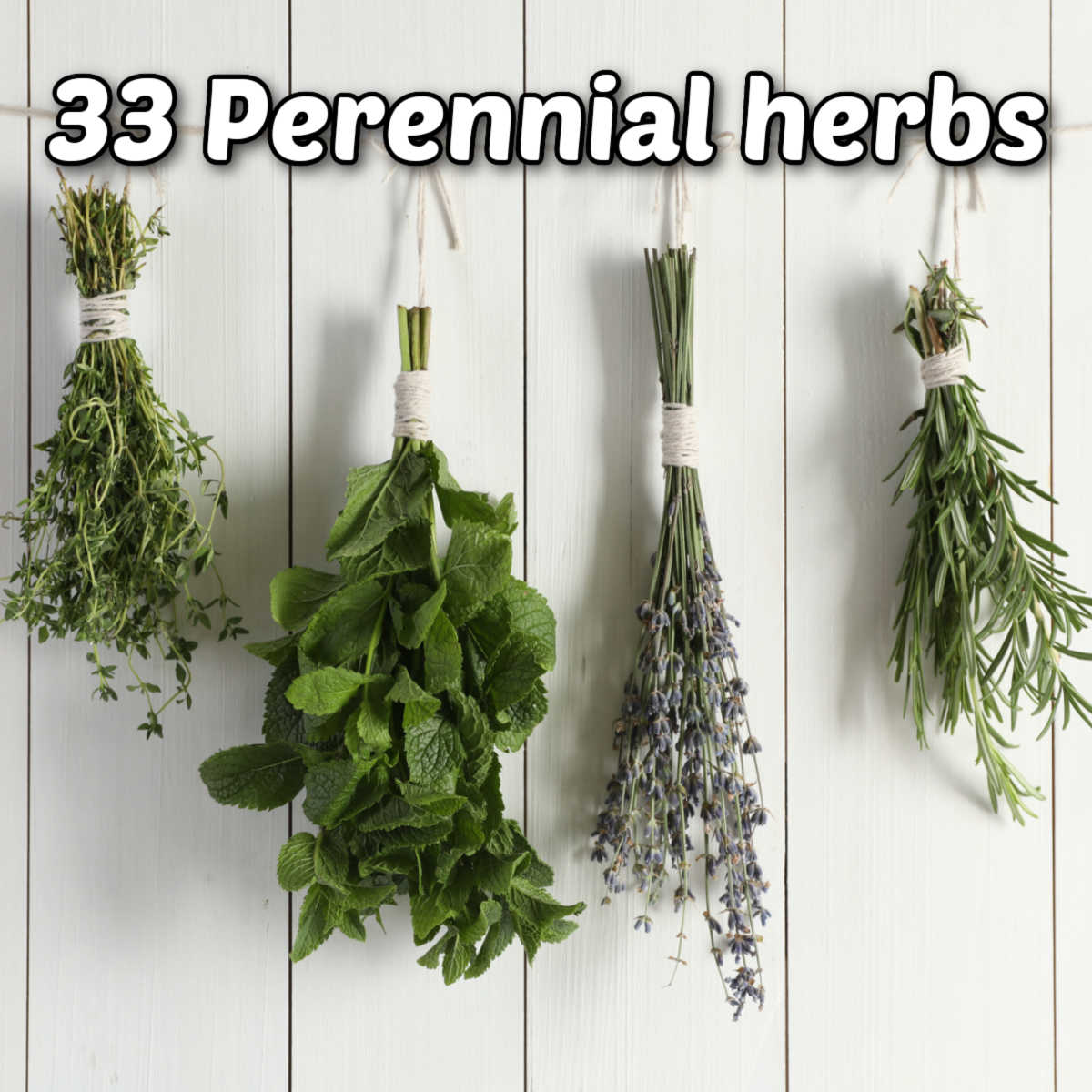
FAQs about perennial herbs
Here are some questions that I often receive from readers about perennial herbs.
1. What is a perennial herb?
A perennial herb is a plant that lives for more than two years. It regrows each spring from its roots and doesn’t need to be replanted each season the way an annual herb does.
2. What are the easiest perennial herbs for beginners to grow?
Popular herb choices for beginners are chives, mint, oregano, rosemary, thyme, and sage. They adapt well to many gardens and are easy to grow.
3. Do perennial herbs survive the winter?
As long as your hardiness zone matches the plant you have chosen, most perennial herbs tolerate the cold well. Some may need some winter protection in colder climates.
4. Are there perennial herbs for shade gardens?
Several perennial herbs like mint, chives, lemon balm, and sweet woodruff can tolerate partial shade.
Perennial herbs list printable
If you’d like a reminder of this identification guide, you can print out a list of perennial herbs as a high-resolution image here. You can also get the printable from the project card at the bottom of the post in a slightly smaller size.
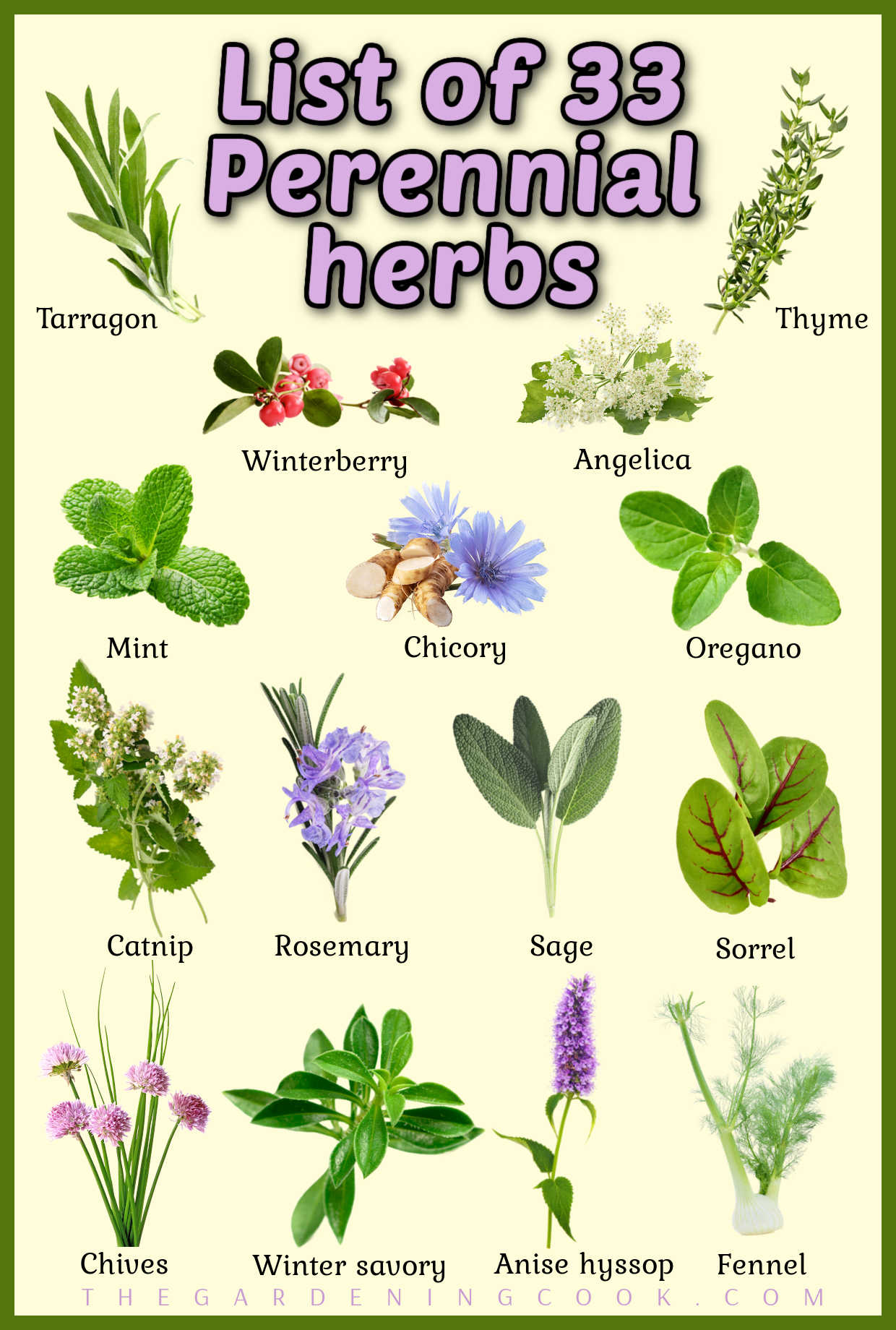
Learn more about perennial herbs
If you enjoyed learning about perennial herbs, be sure to check out these herb posts.
- 11 best herbs for kitchen gardens – Plan which annual and perennial herbs to use in your indoor herb garden.
- 7 ways to freeze herbs – Preserve your herbs to use in recipes during the winter.
- Annual vs biennial vs perennial herbs – Learn more about the life cycle of herbs.
Share this perennial herb list on X
If you enjoyed learning about these perennial herbs, why not share this guide with a friend? Here is a post to get you started:
🌿 Looking for more herbs to add to your garden? Get a list of perennial herbs that will return year after year.🌱✨ #HerbGarden #PerennialHerbs #GardenTips #Herbs Share on XNow it is your turn. Which of the plants from this list of perennial herbs do you use most often in your recipes? Let us know in the comments below.
Pin this post identifying perennial herbs
Would you like a reminder of this visual guide to perennial herbs? Pin this image to one of your gardening boards on Pinterest so that you can easily find it later.
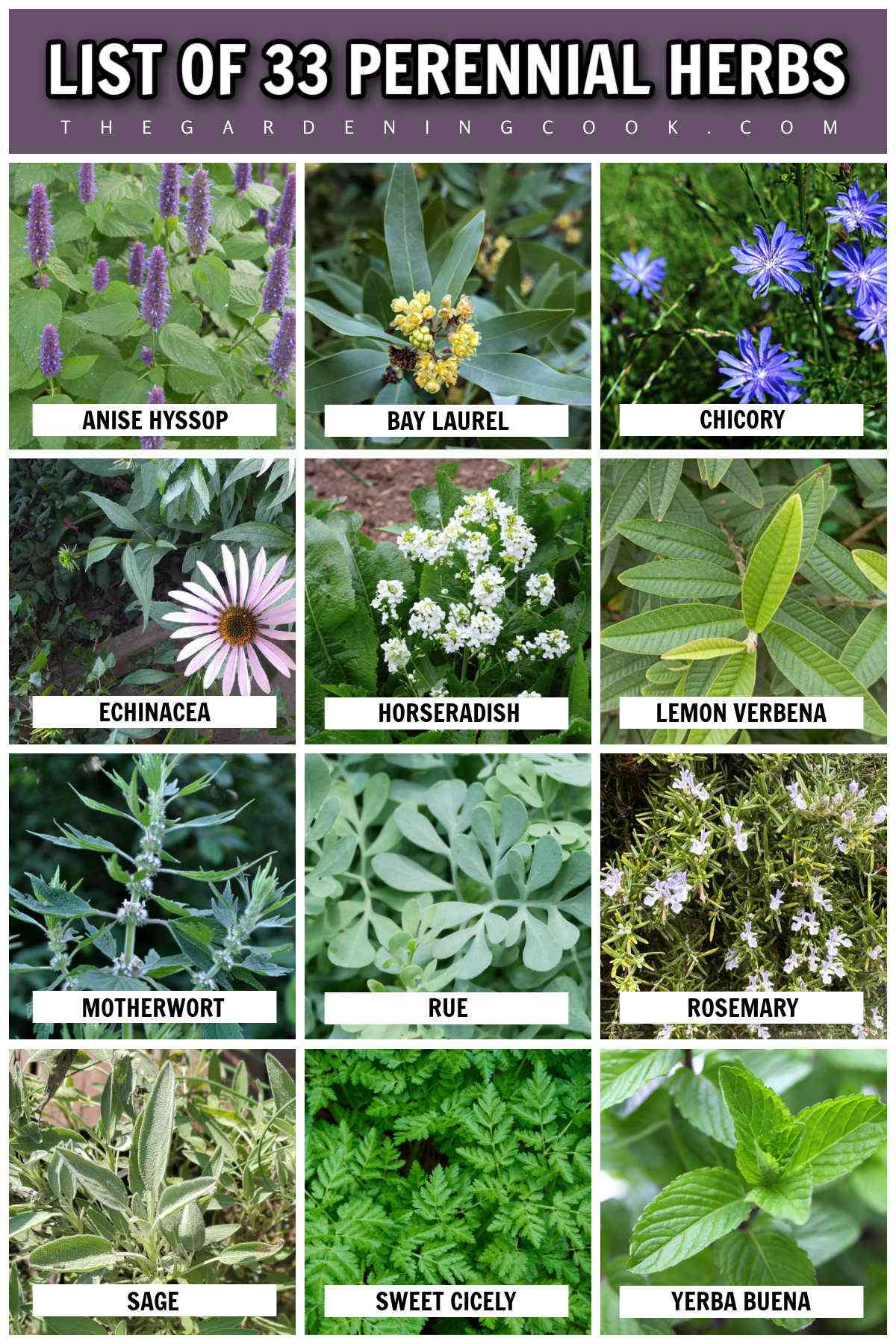
You can also watch this YouTube slideshow video with photos and names of perennial herbs!
List of 33 Perennial Herbs - Free Printable
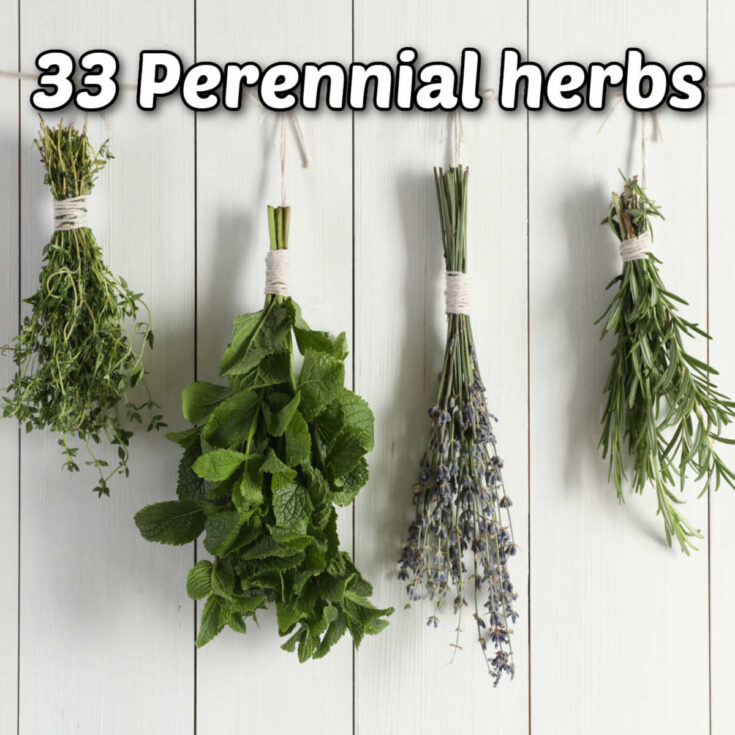
Perennial herbs are those that you can plant once and they will come back each year without replanting.
This list of perennial herbs features 33 herbs to choose from. Some are commonly used, while others are harder to find.
Download this printable list of perennial herbs and save it for future reference when shopping for your garden.
Materials
- Printer paper
Tools
- Computer
- Printer
Instructions
- Load your computer paper into your printer.
- Using the print function on this card will give you a list of perennial herbs with names and photos that fills about ¾ of an 8.5 x 11-inch sheet of paper.
- Choose portrait layout and, if possible, "fit to page" in your settings. Doing this will fill the entire page.
- Alternatively, you can use this link to print the herb garden infographic as a high-resolution image, using the print feature in your browser window.
- After you get this list of herbs, you can use it for future reference to help you identify them in your garden or at a nursery.
- Please note: Free gardening printables take a long time to make. This list of perennial herbs is for personal use only. If you are sharing this list (and thank you for that!), please link directly to this post and not to the actual image. We appreciate your help in supporting the site. This gardening printable may not be used for any retail purpose or mass distribution.
Notes

Recommended Products
As an Amazon Associate and member of other affiliate programs, I earn from qualifying purchases.



Amanda
Monday 12th of April 2021
I keep a Rosemary shrub year round since I use this herb so much. In the summer, I keep fresh mozzarella in the fridge and when the cherry tomatoes are ripe, snip some basil for caprese salad bites. :) I use Thyme quite a bit, sage in the colder months, and tons of oregano. Hoping to establish a hardy herb garden in my new home and am looking forward to exploring fresh marjarom and tarragon. I planted lavender because I have fond memories of the bush if not the herb so hoping that will take off.
Carol Speake
Monday 12th of April 2021
Sounds like dinner at your house is special!
Carol moorby
Friday 25th of October 2019
I want to start an herb 🌿 garden inside this winter and have an herb table with 8 cloth pockets. Can I start with seeds and when should I start? Will it take all winter long to see results and can I continue To grow them in the containers all through the 2020 season including spring and summer?
Carol Speake
Tuesday 29th of October 2019
If you have very good light in your home, herbs will grow just fine indoors. If you are starting them to have outdoors in spring, just plant the seeds about 6 weeks before the last frost in your area.